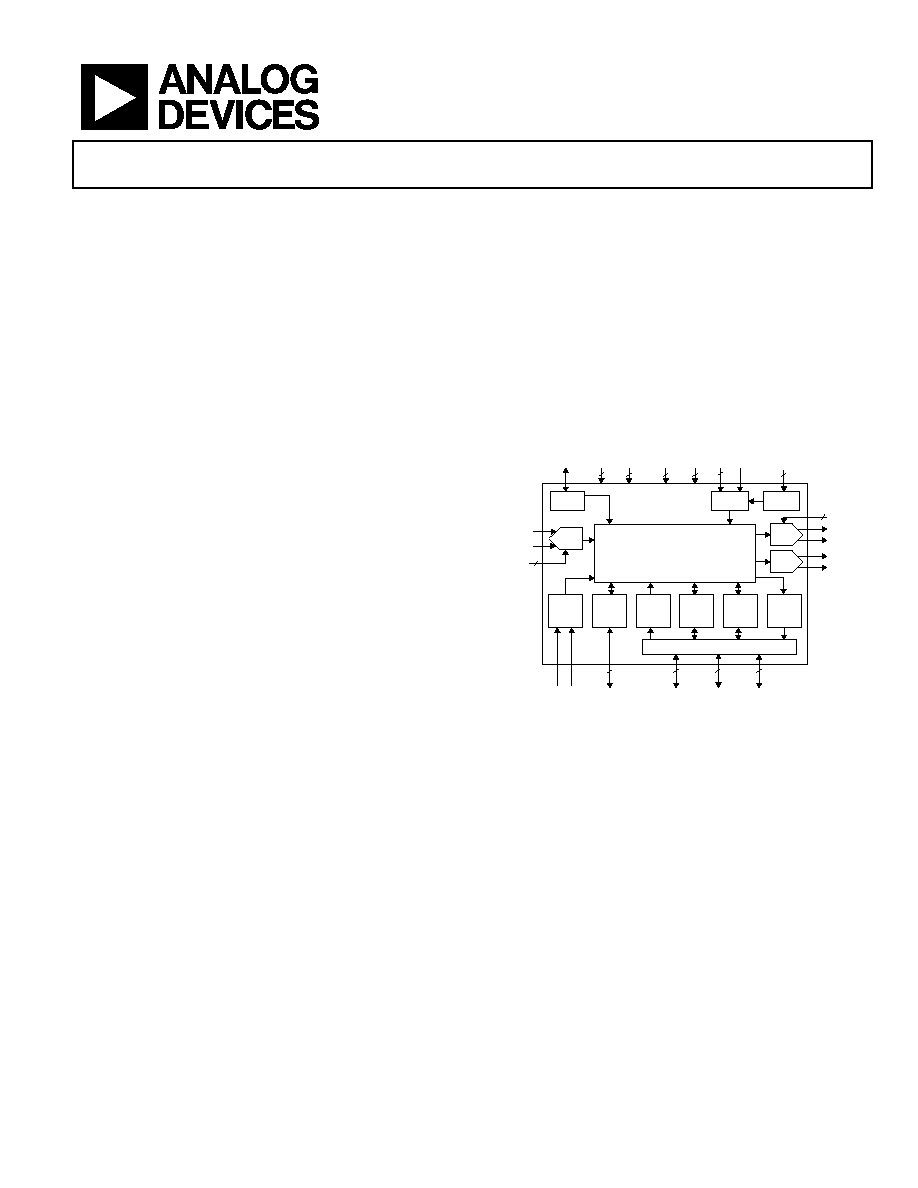
SigmaDSP
Æ
28/56-Bit Audio
Processor with 2ADC/4DAC
Preliminary Technical Data
ADAU1701
FEATURES
28/56-bit, 50 MHz digital audio processor
Stereo ADC: 100 dB SNR and -80 dB THD+N
4-channel DAC: 104 dB SNR and -90 dB THD+N
Complete stand-alone operation
∑
Self-boot from serial EEPROM
∑
Auxiliary ADC with four-input mux for analog
control
∑
GPIOs for digital controls and outputs
Fully programmable with SigmaStudioTM graphical tool
28-bit ◊ 28-bit multiplier with 56-bit accumulator for full
double precision processing
Clock Oscillator for generating master clock from crystal
PLL for generating master clock from 64 ◊ f
S
, 256 ◊ f
S
,
384 ◊ f
S
, or 512 ◊ f
S
clocks
Flexible serial data I/O ports with I
2
S compatible, left-
justified, right-justified, and TDM modes
Sampling rates up to 192 kHz supported
On-chip voltage regulator for compatibility with 3.3 V
systems
48-lead LQFP plastic package
APPLICATIONS
Multimedia speaker systems
MP3 player speaker docks
Automotive head units
Mini-component stereos
Digital televisions
Studio monitors
Speaker crossovers
Musical instrument effects processors
In-seat sound systems (aircraft/motor coaches)
FUNCTIONAL BLOCK DIAGRAM
3
3
3
3
3
2
2
2
5
4
4
4
CONTROL
INTERFACE
AND
SELFBOOT
8-CH
DIGITAL
INPUT
8-BIT
AUX
ADC
GPIO
8-CH
DIGITAL
OUTPUT
RESET/
MODE
SELECT
STEREO
ADC
I2C/SPI &
WRITEBACK
RESET
SELF
BOOT
INPUT/OUTPUT MATRIX
AUX ADC
OR
GPIO
DIGITAL OUT
OR
GPIO
DIGITAL IN
OR
GPIO
DAC
DAC
28/56-BIT, 50 MHz
AUDIO PROCESSOR CORE
40 ms DELAY MEMORY
S
4-CHANNEL
ANALOG
OUTPUT
FILTD / CM
CLOCK
OSCILLATOR
CRYSTAL
PLL
PLL
LOOP
FILTER
PLL
MODE
ANALOG
GROUND
ANALOG
VDD
DIGITAL
GROUND
DIGITAL
VDD
1.8 V
REGULATOR
3.3 V
2-CHANNEL
ANALOG
INPUT
FILTA /
ADC_RES
Figure 1.
GENERAL DESCRIPTION
The ADAU1701 is a complete audio system-on-a-chip
including a 28/56-bit audio DSP, ADCs and DACs, and
microcontroller-like control interfaces. Signal processing
includes equalization, crossover, bass enhancement, multiband
dynamics processing, delay compensation, speaker
compensation, and stereo image widening. These algorithms
can be used to compensate for the real-world limitations of
speakers, amplifiers, and listening environments, resulting in a
dramatic improvement of perceived audio quality.
The signal processing used in the ADAU1701 is comparable to
that found in high end studio equipment. Most of the
processing is done in full 56-bit double-precision mode,
resulting in very good low level signal performance. The
ADAU1701 is a fully-programmable DSP. The easy-to-use
SigmaStudio software allows the user to graphically configure a
custom signal processing flow using blocks such as biquad
filters, dynamics processors, level controls, and GPIO interface
controls.
ADAU1701 programs can be loaded on power-up either from a
serial EEPROM though its own self-boot mechanism or from
an external microcontroller. On power-down, the current state
of the parameters can be written back to the EEPROM from the
ADAU1701 to be recalled the next time the program is run.
The ADAU1701's two sigma-delta (- ) ADCs and four -
DACs provide an analog-in to analog-out dynamic range
greater than 100 dB. The ADC's THD+N is -80 dB and the
DAC's is -90 dB. Digital input and output ports allow a glueless
connection to additional ADCs and DACs. The ADAU1701
communicates through either an I
2
C bus or a 4-wire SPI port.
Rev. PrF
Information furnished by Analog Devices is believed to be accurate and reliable. However, no
responsibility is assumed by Analog Devices for its use, nor for any infringements of patents or other
rights of third parties that may result from its use. Specifications subject to change without notice. No
license is granted by implication or otherwise under any patent or patent rights of Analog Devices.
Trademarks and registered trademarks are the property of their respective owners.
One Technology Way, P.O. Box 9106, Norwood, MA 02062-9106, U.S.A.
Tel: 781.329.4700
www.analog.com
Fax: 781.461.3113
©2006 Analog Devices, Inc. All rights reserved.

ADAU1701
Preliminary Technical Data
Rev. PrF | Page 2 of 43
TABLE OF CONTENTS
Features .............................................................................................. 1
Applications....................................................................................... 1
Functional Block Diagram .............................................................. 1
General Description ......................................................................... 1
Specifications..................................................................................... 4
Analog Performance .................................................................... 4
Digital I/O ..................................................................................... 5
Power.............................................................................................. 5
Temperature Range ...................................................................... 5
Digital Timing............................................................................... 5
PLL ................................................................................................. 6
Regulator........................................................................................ 6
Absolute Maximum Ratings............................................................ 7
ESD Caution.................................................................................. 7
Typical Performance Characteristics ............................................. 8
Pin Configuration and Functions................................................. 10
Overview.......................................................................................... 13
Initialization .................................................................................... 14
Power-Up Sequence ................................................................... 14
Recommended Program/Parameter Loading Procedure ..... 14
Power Reduction Modes............................................................ 14
Using the Oscillator.................................................................... 14
Setting Master Clock/PLL Mode .............................................. 15
Voltage Regulator ....................................................................... 15
Two-Channel Audio ADC............................................................. 17
Four-Channel Audio DAC ............................................................ 18
Control Port..................................................................................... 19
Overview...................................................................................... 19
I
2
C Port ........................................................................................ 19
SPI Port ........................................................................................ 20
Self boot ....................................................................................... 23
Signal Processing ............................................................................ 25
Overview ..................................................................................... 25
Numeric Formats ....................................................................... 25
Programming.............................................................................. 25
RAMs and Registers....................................................................... 26
Control Port Addressing ........................................................... 26
Parameter RAM.......................................................................... 26
Safeload Registers ....................................................................... 27
Data Capture Registers .............................................................. 27
DSP Core Control Register ....................................................... 28
Interface Registers ...................................................................... 28
Control Port Read/Write Data Formats .................................. 28
Data RAM ................................................................................... 30
Multipurpose Pins .......................................................................... 31
MultiPurpose pin Configuration Registers ............................ 31
GPIO pin Setting Register......................................................... 31
Auxiliary ADC............................................................................ 31
General Purpose Input/Outputs .............................................. 32
Serial Data Input/Output Ports ................................................ 32
Serial Output Control Registers ............................................... 34
Serial Input Control Register .................................................... 35
Layout Recommendations............................................................. 37
Parts Placement .......................................................................... 37
Grounding ................................................................................... 37
Typical Application Schematic ≠ Self Boot Mode...................... 38
Typical Application Schematic ≠ I
2
C Control............................. 39
Typical Application Schematic ≠ SPI Control ............................ 40
Digital Timing Diagrams............................................................... 41
Outline Dimensions ....................................................................... 43
Ordering Guide .......................................................................... 43
REVISION HISTORY

Preliminary Technical Data
ADAU1701
Rev. PrF | Page 3 of 43
4/06--Preliminary Version PrF
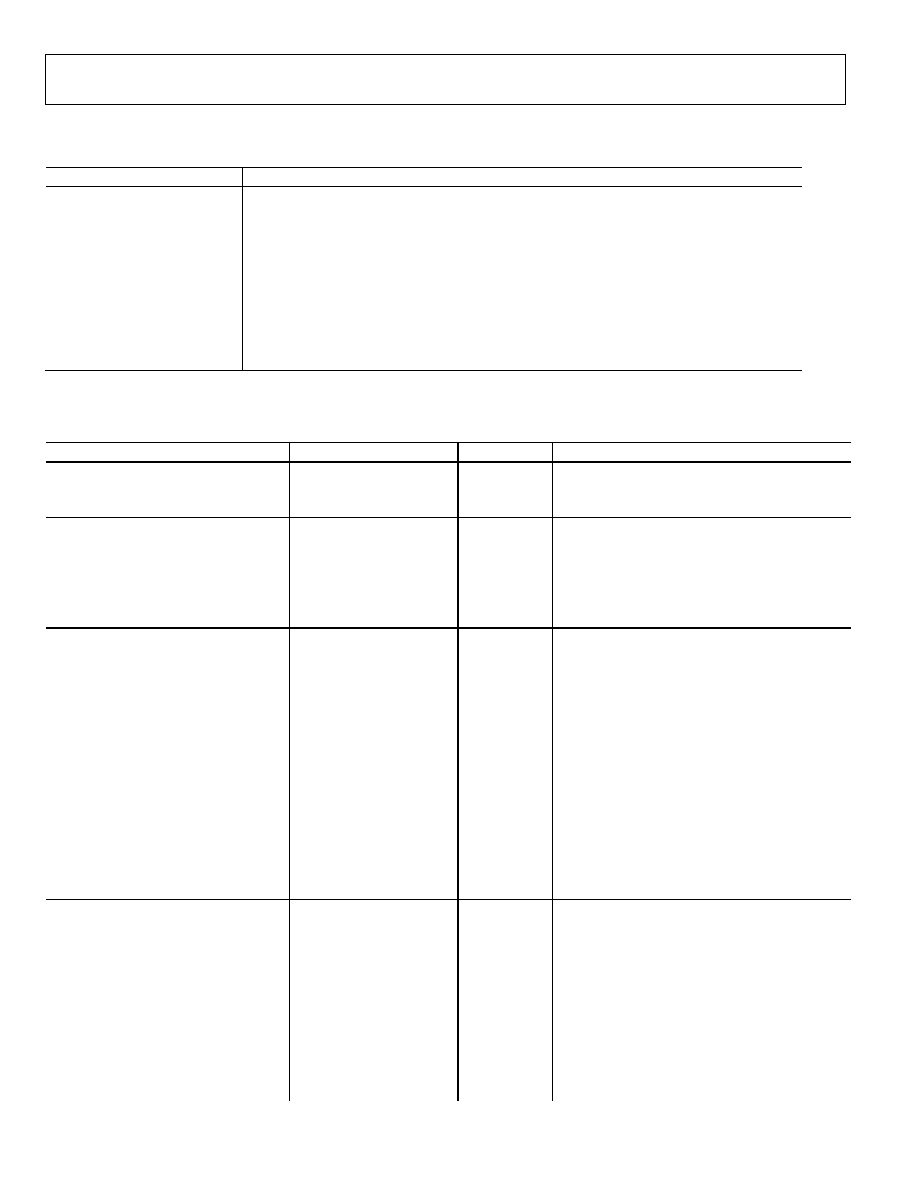
ADAU1701
Preliminary Technical Data
Rev. PrF | Page 4 of 43
SPECIFICATIONS
Table 1. Test conditions, unless otherwise noted
Parameter Conditions
Analog Supply Voltage (AVDD)
3.3 V
Digital Supply Voltage (DVDD)
1.8 V
PLL Voltage (PVDD)
3.3 V
Input/Output Voltage (IOVDD)
3.3 V
Ambient Temperature
25∞ C
Master Clock Input
12.288 MHz
Load Capacitance
Load Current
Input Voltage, HI
Input Voltage, LO
ANALOG PERFORMANCE
Table 2. Analog Performance
Parameter Min
Typical
Max
Units
Test
Conditions/Comments
VOLTAGE REFERENCE
Absolute Voltage (CM, FILTA, FILTD)
1.5
V
Temperature Coefficient
130
ppm/∞C
AUX ANALOG INPUTS
Full Scale Analog Input
3.3
V
INL
TBD
DNL
TBD
Offset
TBD
mV
Input impedance
30
k
ADC INPUTS
Number of channels
2
Stereo input
Resolution
24
Bits
Full Scale Input
100 (283)
A
rms
(A p-p)
2V
rms
input with 20k (18 k external + 2 k
internal) series resistor
Signal-to-Noise Ratio
A-Weighted
100
dB
Dynamic Range
-60dB with respect to full scale Analog input
A-Weighted
100
dB
Total Harmonic Distortion + Noise
-80
dB
-1 dB with respect to full scale Analog input
Interchannel Gain Mismatch
TBD
dB
Left and Right channel Gain Mismatch
Crosstalk
TBD
dB
Analog channel-to-channel crosstalk
DC Bias
1.5
V
Gain Error
TBD
%
Power Supply Rejection
TBD
dB
1kHz, 300mV
P-P
Signal at AVDD
DAC OUTPUTS
Number of channels
4
2 stereo output channels
Resolution
24
Bits
Full Scale Analog Output
0.9 (2.5)
V
rms
(V pp)
Signal-to-Noise Ratio
A-Weighted
104
dB
Dynamic Range
-60dB with respect to full scale Analog input
A-Weighted
104
dB
Total Harmonic Distortion + Noise
-90
dB
-1 dB with respect to full scale Analog input
Crosstalk
TBD
dB
Analog channel-to-channel crosstalk
Interchannel Gain Mismatch
TBD
dB
Left and Right channel Gain Mismatch

Preliminary Technical Data
ADAU1701
Rev. PrF | Page 5 of 43
Parameter Min
Typical
Max
Units
Test
Conditions/Comments
Gain Error
TBD
%
DC Bias
1.5
V
Power Supply Rejection
TBD
dB
1kHz, 300mV
P-P
Signal at AVDD
DIGITAL I/O
Table 3. Digital I/O
Parameter
Min
Typ
Max
Unit
Input Voltage, HI (V
IH
)
2.0
IOVDD
V
Input Voltage, LO (V
IL
)
0.8
V
Input Leakage, HI (I
IH
)
10
A
Input Leakage, LO (I
IL
)
10
A
High Level Output Voltage (V
OH
), I
OH
= 1 mA
2.0
V
Low Level Output Voltage (V
OL
), I
OL
= 1 mA
0.8
V
Input Capacitance
5
pF
GPIO Output Drive
5
mA
POWER
Table 4.
Parameter
Comments
Min
Typ
Max
1
Unit
Supply Voltage
Analog Voltage
3.3
V
Digital Voltage
1.8
V
PLL Voltage
3.3
V
IOVDD Voltage
3.3
V
Supply Current
Analog Current (AVDD & PVDD)
65
85
mA
Digital Current (DVDD)
40
60
mA
PLL Current
TBD
mA
Analog Current, Reset
TBD
mA
Digital Current, Reset
TBD
mA
PLL Current, Reset
TBD
mA
Dissipation
Operation (AVDD, DVDD, PVDD)
2
286.5
mW
Reset, all supplies
TBD
mW
1
Maximum specifications are measured across
-xx∞C to xx∞C (case) and across VDD = xxx V to xxx V.
2
Power dissipation does not include IOVDD power because the current draw from this supply is dependant on loads on the digital output pins.
TEMPERATURE RANGE
Table 5.
Parameter
Min
Typ
Max
Unit
Functionality Guaranteed
0∞C
70∞C
∞C Ambient
DIGITAL TIMING
Table 6 Digital Timing
1
Parameter
Comments
Min
Max
Unit
MASTER CLOCK
t
MP
MCLK Period
512 f
S
mode
36
244
ns
t
MP
MCLK Period
384 f
S
mode
48
366
ns
t
MP
MCLK Period
256 f
S
mode
73
488
ns
t
MP
MCLK Period
64 f
S
mode
291
1953
ns
SERIAL PORT
t
BIL
INPUT_BCLK LO Pulse Width
40
ns
t
BIH
INPUT_BCLK HI Pulse Width
40
ns
t
LIS
INPUT_LRCLK Setup
To INPUT_BCLK rising
10
ns
t
LIH
INPUT_LRCLK Hold
From INPUT_BCLK rising
10
ns
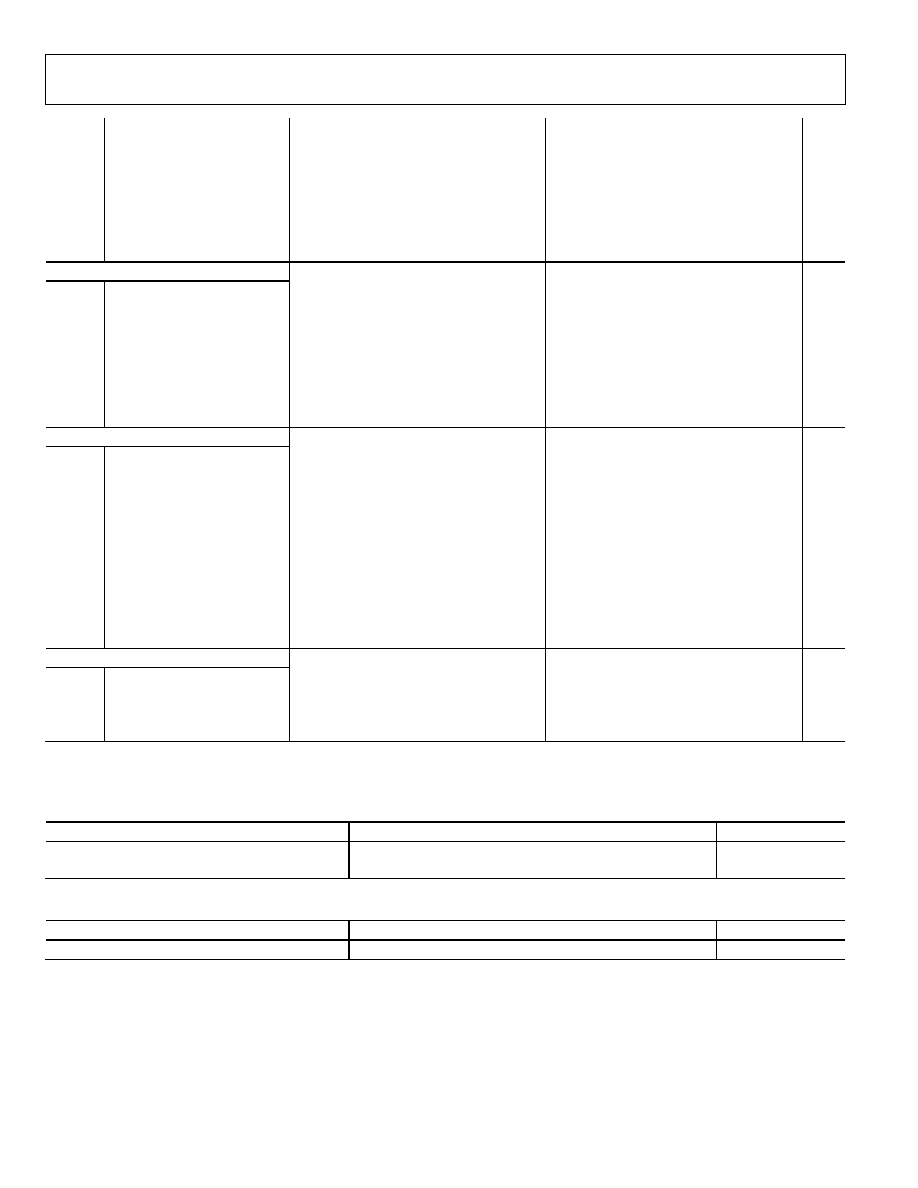
ADAU1701
Preliminary Technical Data
Rev. PrF | Page 6 of 43
t
SIS
SDATA_INx Setup
To BCLK_IN rising
10
ns
t
SIH
SDATA_INx Hold
From BCLK_IN rising
10
ns
t
LOS
OUTPUT_LRCLK Setup
Slave mode
10
ns
t
LOH
OUTPUT_LRCLK Hold
Slave mode
10
ns
t
TS
OUTPUT_BCLK Falling to
OUTPUT_LRCLK Timing Skew
ns
t
SODS
SDATA_OUTx Delay
Slave mode, from OUTPUT_BCLK falling
40
ns
t
SODM
SDATA_OUTx Delay
Master mode, from OUTPUT_BCLK falling
40
ns
SPI PORT
t
CCPL
CCLK Pulse Width LO
TBD
ns
t
CCPH
CCLK Pulse Width HI
TBD
ns
t
CLS
CLATCH Setup
To CCLK rising
TBD
ns
t
CLH
CLATCH Hold
From CCLK rising
TBD
ns
t
CLPH
CLATCH Pulse Width HI
TBD
ns
t
CDS
CDATA Setup
To CCLK rising
TBD
ns
t
CDH
CDATA Hold
From CCLK rising
TBD
ns
t
COD
COUT Delay
From CCLK rising
TBD
ns
I
2
C PORT
f
SCL
SCL Clock Frequency
400
kHz
t
SCLH
SCL
High
0.6
s
t
SCLL
SCL
Low
1.3
s
t
SCS
Setup Time
Relevant for Repeated Start Condition
0.6
s
t
SCH
Hold Time
After this period the 1st clock is generated
0.6
s
t
DS
Data
Setup
Time
100
ns
t
SCR
SCL
Rise
Time
300
ns
t
SCF
SCL
Fall
Time
300
ns
t
SDR
SDA
Rise
Time
300
ns
t
SDF
SDA
Fall
Time
300
ns
t
BFT
Bus-Free Time
Between Stop and Start
0.6
MULTIPURPOSE PINS & RESET
t
GRT
GPIO
Rise
Time
TBD
ns
t
GFT
GPIO
Fall
Time
TBD
ns
t
GIL
GPIO Input Latency
Until high/low value read by core
1.5 ◊ 1/fs
s
t
RLPW
RESETB LO Pulse Width
20
ns
1
All timing specifications are given for the default (I
2
S) states of the serial input control port and the serial output control ports. See
Table 45.
PLL
Table 7.
Parameter
Min
Typ
Max
Unit
Operating Range
TBD
TBD
MHz
Lock Time
20
ms
REGULATOR
1
Table 8.
Parameter
Min
Typ
Max
Unit
DVDD Voltage
1.8
V
1
Regulator specifications are calculated using an FZT953 transistor in the circuit.
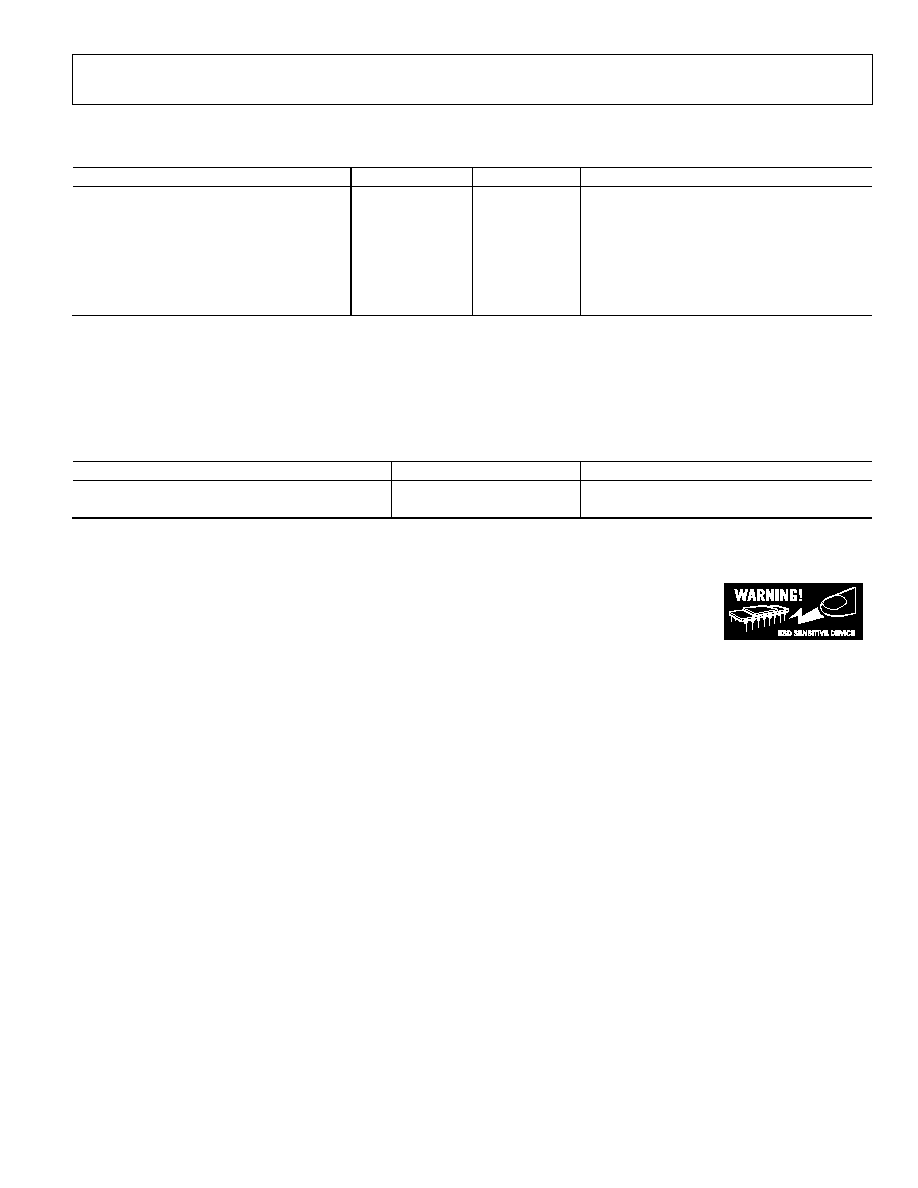
Preliminary Technical Data
ADAU1701
Rev. PrF | Page 7 of 43
ABSOLUTE MAXIMUM RATINGS
Table 9.
Parameter
Min
Max
Unit
DVDD to GND
0
2.2
V
AVDD to GND
0
4.0
V
IOVDD to GND
0
4.0
V
Digital Inputs
DGND - 0.3
IOVDD + 0.3
V
Maximum Junction Temperature
135
∞C
Storage Temperature Range
≠65
+150
∞C
Soldering (10 sec)
300
∞C
Stresses above those listed under Absolute Maximum Ratings may cause permanent damage to the device. This is a stress rating only;
functional operation of the device at these or any other conditions above those indicated in the operational section of this specification is
not implied. Exposure to absolute maximum rating conditions for extended periods may affect device reliability.
Table 10. Package Characteristics
Parameter Min
Typ
Max
Unit
JA
Thermal Resistance (Junction-to-Ambient)
72
∞C/W
JC
Thermal Resistance (Junction-to-Case)
19.5
∞C/W
ESD CAUTION
ESD (electrostatic discharge) sensitive device. Electrostatic charges as high as 4000 V readily accumulate on
the human body and test equipment and can discharge without detection. Although this product features
proprietary ESD protection circuitry, permanent damage may occur on devices subjected to high energy
electrostatic discharges. Therefore, proper ESD precautions are recommended to avoid performance
degradation or loss of functionality.
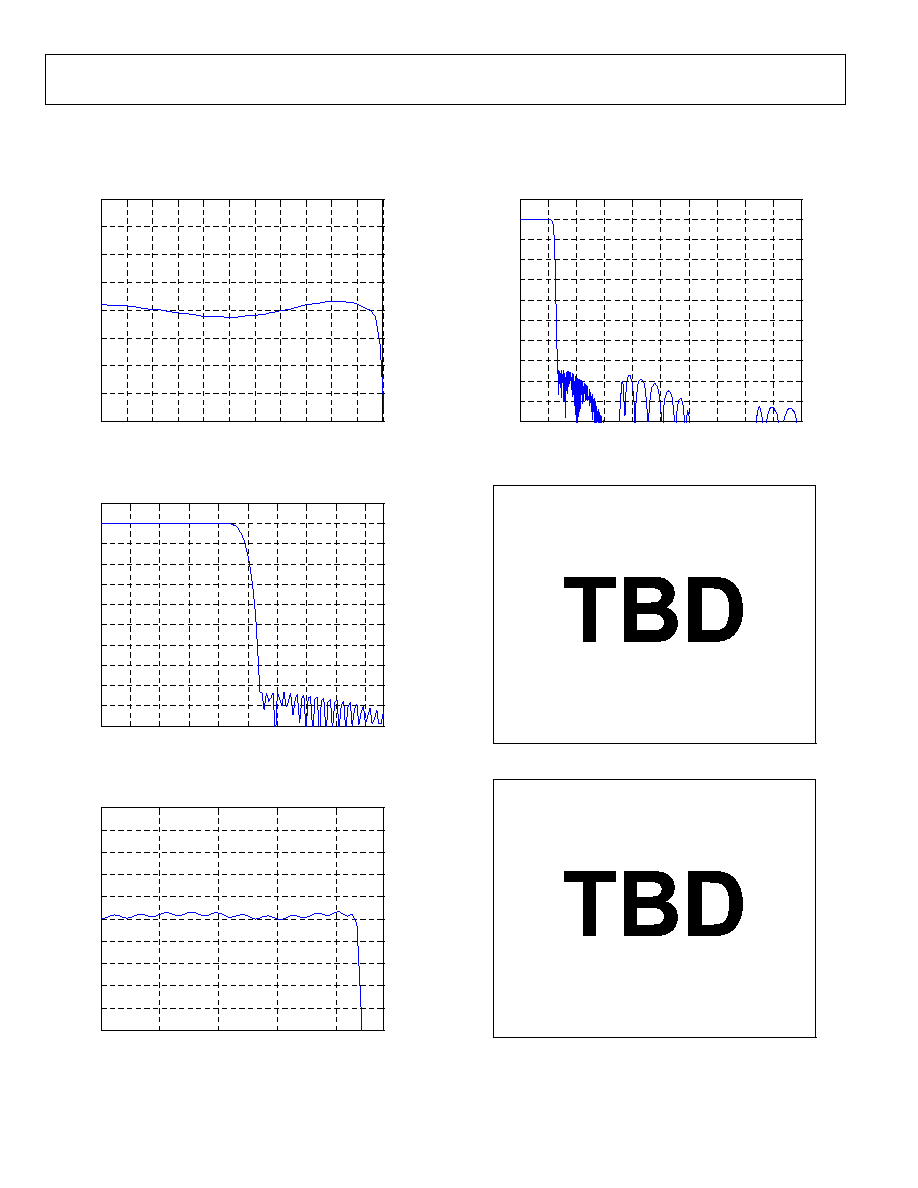
ADAU1701
Preliminary Technical Data
Rev. PrF | Page 8 of 43
TYPICAL PERFORMANCE CHARACTERISTICS
0
0.2
0.4
0.6
0.8
1
1.2
1.4
1.6
1.8
2
2.2
x 10
4
-0.2
-0.15
-0.1
-0.05
0
0.05
0.1
0.15
0.2
dB
Frequency
ADC Decimation filter Passband Ripple, Fs = 48KHz
Figure 2. ADC Passband Filter Response, fs=48 kHz
0
0.5
1
1.5
2
2.5
3
3.5
4
4.5
x 10
4
-100
-90
-80
-70
-60
-50
-40
-30
-20
-10
0
10
dB
Frequency
ADC Decimation filter Total Response, Fs = 48KHz
Figure 3. ADC Stopband Filter Response, fs=48 kHz
0
0.5
1
1.5
2
x 10
4
-0.1
-0.08
-0.06
-0.04
-0.02
0
0.02
0.04
0.06
0.08
0.1
dB
Frequency
DAC Passband response, Fs = 48KHz
Figure 4. DAC Passband Filter Response, fs=48 kHz
0
0.2
0.4
0.6
0.8
1
1.2
1.4
1.6
1.8
2
x 10
5
-100
-90
-80
-70
-60
-50
-40
-30
-20
-10
0
10
dB
Frequency
DAC Total response, Fs = 48KHz
Figure 5. DAC Stopband Filter Response, fs=48 kHz
Figure 6. ADC frequency response with 1 kHz, -60 dBFS input
Figure 7. ADC frequency response with 1 kHz, 0 dBFS input
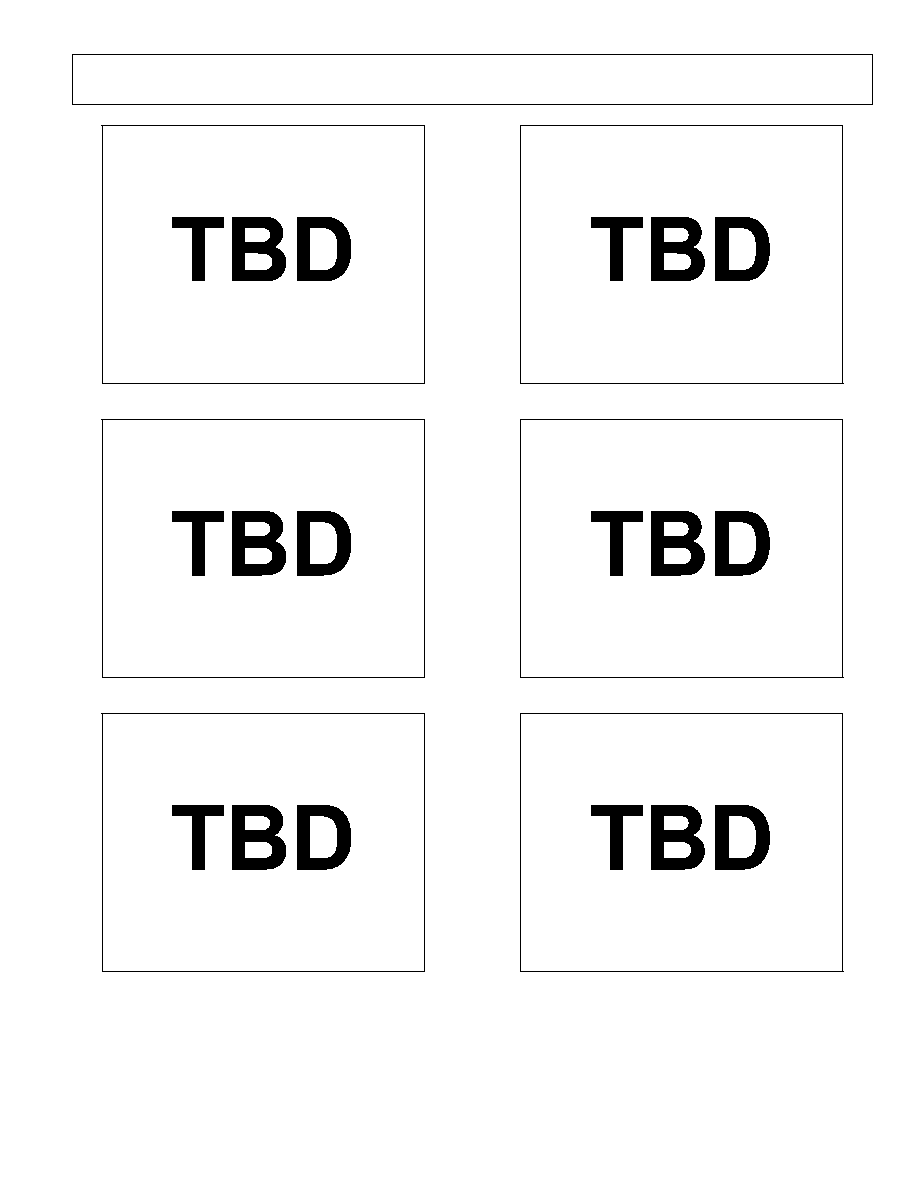
Preliminary Technical Data
ADAU1701
Rev. PrF | Page 9 of 43
Figure 8. ADC Total Harmonic Distortion + Noise vs. frequency
Figure 9. DAC frequency response with 1 kHz, -60 dBFS input
Figure 10. DAC frequency response with 1 kHz, 0 dBFS input
Figure 11. DAC Total Harmonic Distortion + Noise vs. frequency
Figure 12. Crosstalk vs. frequency
Figure 13. PSRR vs. frequency
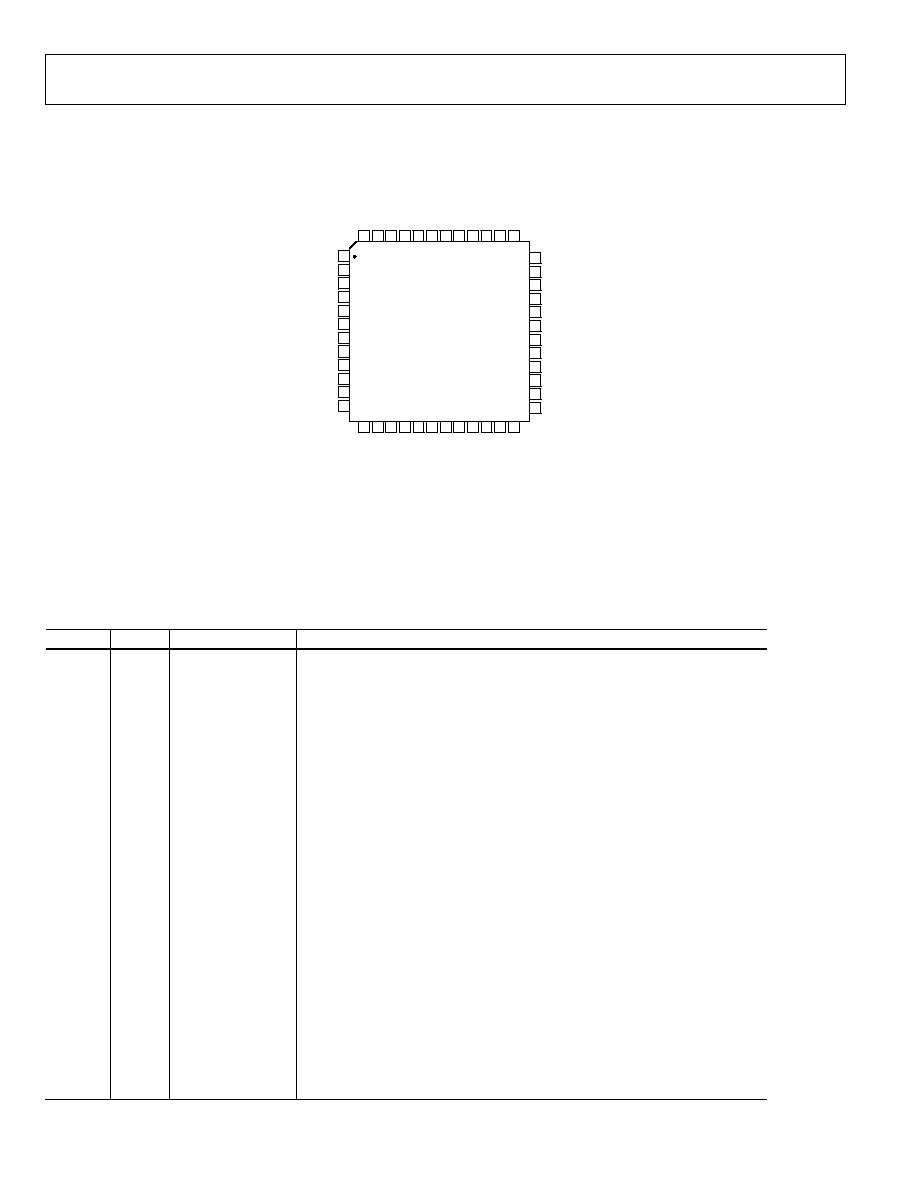
ADAU1701
Preliminary Technical Data
Rev. PrF | Page 10 of 43
PIN CONFIGURATION AND FUNCTIONS
36
35
34
33
32
31
30
29
28
27
26
25
13 14 15 16 17 18 19 20 21 22 23 24
1
2
3
4
5
6
7
8
9
10
11
12
48 47 46 45 44
39 38 37
43 42 41 40
TOP VIEW
(Not to Scale)
AVDD
PLL_LF
PVDD
PGND
MCLKI
MP8
OSCO
AGND
ADC1
ADC_RES
ADC0
RESETB
SELFBOOT
ADDR0
MP4
MP5
MP1
DGND
RSVD
MP2
MP3
MP9
ADAU1701
MP0
DGND
A
V
D
D
F
I
L
T
A
V
O
U
T
0
V
O
U
T
1
V
O
U
T
2
V
O
U
T
3
A
G
N
D
F
I
L
T
D
C
M
P
L
L
_
M
O
D
E
1
P
L
L
_
M
O
D
E
0
A
G
N
D
D
V
D
D
M
P
7
M
P
6
M
P
1
0
V
D
R
I
V
E
I
O
V
D
D
M
P
1
1
A
D
D
R
1
/
C
D
A
T
A
/
W
B
C
L
A
T
C
H
/
W
P
S
D
A
/
C
O
U
T
S
C
L
/
C
C
L
K
D
V
D
D
Figure 14. 48-Lead LQFP Pin Configuration
Table 11. Pin Function Descriptions
Pin No.
Type
1
Mnemonic
Description
1 PWR
AGND
AGND is an analog ground pin. The AGND, DGND, and PGND pins can be tied
directly together in a common ground plane. AGND should be decoupled to an
AVDD pin with a 100 nF capacitor.
2 A_IN
ADC1
Analog input 1, full-scale 100 A rms input. Current input allows input voltage
level to be scaled with an external resistor.
3 A_IN
ADC_RES
ADC reference current. The full-scale current of the ADCs can be set with an
external resistor connected between this pin and ground.
4 A_IN
ADC0
Analog Input 0, full-scale 100 A rms input. Current input allows input voltage
level to be scaled with an external resistor.
5 D_IN
RESETB
RESETB is an active-low reset input. Reset is triggered on a high-to-low edge and
the part will exit reset on a low-to-high edge. For detailed information about
initialization, see the Power-Up Sequence section.
6 D_IN
SELFBOOT SELFBOOT selects control port (0) or self-boot (1). Setting this pin high will
initiate a selfboot operation when the ADAU1701 is brought out of reset. This pin
can be tied directly to the control voltage or pulled up/down with a resistor.
7 D_IN
ADDR0
I
2
C and SPI Address 0, in combination with ADDR1will allow up to four
ADAU1701s to be used on the same I
2
C bus and up to two ICs to be used with a
common SPI CLATCH signal.
8
D_IO
MP4
Multi-Purpose ≠ GPIO or Serial input port LRCLK (INPUT_LRCLK)
9
D_IO
MP5
Multi-Purpose ≠ GPIO or Serial input port BCLK (INPUT_BCLK)
10
D_IO
MP1
Multi-Purpose ≠ GPIO or Serial Input port data 1 (SDATA_IN0)
11
D_IO
MP0
Multi-Purpose ≠ GPIO or Serial Input port data 0 (SDATA_IN1)
12 PWR
DGND
DGND is a digital ground pin. The AGND, DGND, and PGND pins can be tied
directly together in a common ground plane. DGND should be decoupled to a
DVDD pin with a 100 nF capacitor.
13 PWR
DVDD
1.8 V Digital Supply. This can be supplied either externally or generated from a
3.3 V supply with the on-board 1.8 V regulator. DVDD should be decoupled to

Preliminary Technical Data
ADAU1701
Rev. PrF | Page 11 of 43
DGND with a 100 nF capacitor.
14
D_IO
MP7
Multi-Purpose ≠ GPIO or Serial output port data 1 (SDATA_OUT1)
15 D_IO
MP6
Multi-Purpose ≠ GPIO, Serial output port data 0, or TDM data output
(SDATA_OUT0)
16
D_IO
MP10
Multi-Purpose ≠ GPIO or Serial output port LRCLK (OUTPUT_LRCLK)
17 A_OUT
VDRIVE
Drive for 1.8 V regulator. The base of the voltage regulator's external PNP
transistor is driven from VDRIVE.
18 PWR
IOVDD
Input and Output pins supply. The voltage on this pin sets the highest input
voltage that should be seen on the digital input pins. This pin is also the supply
for the digital output signals on the control port and MP pins. IOVDD should
always be set to 3.3 V. The current draw of this pin is variable because it is
dependant on the loads of the digital outputs.
19
D_IO
MP11
Multi-Purpose ≠ GPIO or Serial output port BCLK (OUTPUT_BCLK)
20 D_IN
ADDR1/CDATA/WB
ADDR1: I
2
C Address 1, in combination with ADDR0 it will set the I
2
C address of
the IC. Four ADAU1701s to be used on the same I
2
C bus.
CDATA: SPI Data Input
WB: EEPROM Writeback trigger. A rising (default) or falling (if set in the EEPROM
messages) edge on this pin will trigger a write-back of the interface registers to
the external EEPROM. This function can be used to save parameter data on
power-down.
21 D_IN
CLATCH
/
WP CLATCH: This SPI latch signal must go low at the beginning of an SPI transaction
and high at the end of a transaction. Each SPI transaction may take a different
number of CCLKs to complete, depending on the address and read/write bit that
are sent at the beginning of the SPI transaction.
WP: Self-boot EEPROM write protect. This pin is an open collector output when in
selfboot mode. The ADAU1701 will pull this low to prohibit writes to an external
EEPROM. This pin should be pulled high to 3.3 V.
22 D_IO
SDA/COUT
SDA: This I
2
C data pin is a bidirectional open collector. The line connected to this
pin should have a 2.2 k pull-up resistor.
COUT: This SPI data output is used for reading back registers and memory
locations. It is three-stated when an SPI read is not active.
23 D_IO
SCL/CCLK
SCL: This I
2
C clock pin is always an open collector input when in I
2
C control mode.
In self-boot mode this pin will be an open collector output (I
2
C master). The line
connected to this pin should have a 2.2 k pull-up resistor.
CCLK: This SPI clock may either run continuously or be gated off in between SPI
transactions.
24 PWR
DVDD
1.8 V Digital Supply. This can be supplied either externally or generated from a
3.3 V supply with the on-board 1.8 V regulator. DVDD should be decoupled to
DGND with a 100 nF capacitor.
25 PWR
DGND
DGND is a digital ground pin. The AGND, DGND, and PGND pins can be tied
directly together in a common ground plane. dGND should be decoupled to a
DVDD pin with a 100 nF capacitor.
26 D/A_IO
MP9
Multi-Purpose ≠ GPIO, serial output port data 3 (SDATA_OUT3), or auxiliary ADC
input 0
27 D/A_IO
MP8
Multi-Purpose ≠ GPIO, serial output port data 2 (SDATA_OUT2), or auxiliary ADC
input 3
28 D/A_IO
MP3
Multi-Purpose ≠ GPIO, serial input port data 3 (SDATA_IN3), or auxiliary ADC
input 2
29 D/A_IO
MP2
Multi-Purpose ≠ GPIO, serial input port data 2 (SDATA_IN2), or auxiliary ADC
input 1
30
X
RSVD
Reserved, tie to ground, either directly or through a pull-down resistor.
31 D_OUT
OSCO
OSCO is the output of the crystal oscillator circuit. A 100 damping resistor
should be connected between this pin and the crystal. This output should not be
used to directly drive a clock to another IC. If the crystal oscillator is not used, this
pin can be left unconnected.
32 D_IN
MCLKI
MCLKI can either be connected to a 3.3 V clock signal or can be the input from
the crystal oscillator circuit.
33 PWR
PGND
PGND is the PLL ground pin. The AGND, DGND, and PGND pins can be tied
directly together in a common ground plane. PGND should be decoupled to

ADAU1701
Preliminary Technical Data
Rev. PrF | Page 12 of 43
PVDD with a 100 nF capacitor.
34 PWR
PVDD
PVDD is the 3.3 V power supply for the PLL and the auxiliary ADC's analog
section. This should be decoupled to PGND with a 100 nF capacitor.
35 A_OUT
PLL_LF
PLL Loop Filter connection. Two capacitors and a resistor need to be connected
to this pin as shown in the Setting Master Clock/PLL Mode section.
36 PWR
AVDD
AVDD is a 3.3 V Analog Supply. This should be decoupled to AGND with a 100 nF
capacitor.
37 PWR
AGND
AGND is an analog ground pin. The AGND, DGND, and PGND pins can be tied
directly together in a common ground plane. AGND should be decoupled to an
AVDD pin with a 100 nF capacitor.
38 D_IN
PLL_MODE0
39 D_IN
PLL_MODE1
PLL_MODE0 and PLL_MODE1 set the output frequency of the master clock PLL.
See the Setting Master Clock/PLL Mode section for more details.
40 A_OUT
CM
CM is the common mode reference. A 47 F decoupling capacitor should be
connected between this pin and ground to reduce crosstalk between the ADCs
and DACs. The capacitor's material is not critical.
41 A_OUT
FILTD
FILTD is the DAC filter decoupling pin, which should be connected to a 10 F
capacitor to ground. The capacitor's material is not critical.
42 PWR
AGND
AGND is an analog ground pin. The AGND, DGND, and PGND pins can be tied
directly together in a common ground plane. AGND should be decoupled to an
AVDD pin with a 100 nF capacitor.
43 A_OUT
VOUT3
44 A_OUT
VOUT2
45 A_OUT
VOUT1
46 A_OUT
VOUT0
VOUT0-3 are the DAC outputs. Full-scale output voltage is 0.9 Vrms. These
outputs can be used with either active or passive output reconstruction filters.
47 A_OUT
FILTA
FILTA is the ADC filter decoupling pin, which should be connected to a 10 F
capacitor to ground. The capacitor's material is not critical.
48 PWR
AVDD
AVDD is a 3.3 V Analog Supply. This should be decoupled to AGND with a 100 nF
capacitor.
1
PWR = Power/Ground, A_IN = analog input, D_IN = digital input, A_OUT = analog output, D_IO = digital input/output, D/A_IO = digital/analog input/output

Preliminary Technical Data
ADAU1701
Rev. PrF | Page 13 of 43
OVERVIEW
The core of the ADAU1701 is a 28-bit DSP (56-bit with double
precision) optimized for audio processing. The program and
parameter RAMs can be loaded with a custom audio processing
signal flow built with ADI's SigmaStudio graphical
programming software. The values stored in the parameter
RAM control individual signal processing blocks, such as IIR
equalization filters, dynamics processors, audio delays, and
mixer levels. A safeload feature allows parameters to be
transparently updated without causing clicks on the output
signals.
The program RAM, parameter RAM, and register contents can
be saved in an external EEPROM, from which the ADAU1701
can self-boot on start-up. In this stand-alone mode, parameters
can be controlled through the on-board multipurpose pins. The
ADAU1701 can accept controls from switches, potentiometers,
rotary encoders, and IR receivers. Parameters such as volume
and tone settings can be saved to the EEPROM on power-down
and recalled when it is powered up again.
The ADAU1701 can operate with either digital I/Os, analog
I/Os, or a mix of both. The stereo ADC and four-channel DAC
each have an SNR of at least 100 dB and THD+N of at least -
80 dB. The flexible serial data input/output ports allow for
glueless interconnection to a variety of ADCs, DACs, general-
purpose DSPs, S/PDIF receivers & transmitters, and sample rate
converters. The ADAU1701 can be configured in I
2
S, left-
justified, right-justified, or TDM serial port compatible modes.
Twelve multi-purpose (MP) pins allow for the ADAU1701 to
input external control signals and output flags or controls to
other devices in the system. These MP pins can be configured
as digital I/Os, inputs to the 4-channel auxiliary ADC, or set up
as the serial data I/O ports. As inputs, they can be connected to
buttons, switches, rotary encoders, potentiometers, IR receivers,
or other external control circuitry to control the internal signal
processing program. When configured as outputs, these pins
can be used to drive LEDs (with a buffer), control other ICs, or
connect to other external circuitry in an application.
The ADAU1701 has a sophisticated control port that supports
complete read/write capability of all memory locations. Control
registers are provided to offer complete control of the chip's
configuration and serial modes. Handshaking is included for
ease of memory uploads and downloads. The ADAU1701 can
be configured for either SPI or I
2
C control.
An on-board oscillator can be connected to an external crystal
to generate the master clock. Also, a master clock phase-locked
loop (PLL) allows the ADAU1701 to be clocked from a variety
of different clock speeds. The PLL can accept inputs of 64 ◊ f
S
,
256 ◊ f
S
, 384 ◊ f
S
, or 512 ◊ f
S
to generate the core's internal
master clock.
The SigmaStudio software is used to program and control the
SigmaDSP through the control port. Along with designing and
tuning a signal flow, the tools can configure the all registers and
burn a new program into the external EEPROM. SigmaStudio's
graphical interface allows anyone with digital or analog audio
processing knowledge to easily design a DSP signal flow and
port it to a target application. It also provides enough flexibility
and programmability for an experienced DSP programmer to
have in-depth control of the design. In SigmaStudio, the user
can simply connect graphical blocks such as biquad filters,
dynamics processors, mixers, and delays, compile the design,
and load the program and parameter files into the ADAU1701's
memory through the control port. Signal processing blocks
available in the provided libraries include
∑
Single- and double-precision biquad filters
∑
Mono and multichannel dynamics processors with peak or
RMS detection
∑
Mixers and splitters
∑
Tone and noise generators
∑
Fixed and variable gain
∑
Loudness
∑
Delay
∑
Stereo enhancement
∑
Dynamic bass boost
∑
Noise and tone sources
∑
Level detectors
∑
GPIO control & conditioning
More processing blocks are always in development. Analog
Devices also provides proprietary and third-party algorithms
for applications such as matrix decoding, bass enhancement,
and surround virtualizers. Please contact ADI for information
about licensing these algorithms.
The ADAU1701 operates from a 1.8 V digital power supply and
a 3.3 V analog supply. An on-board voltage regulator can be
used to operate the chip from a single 3.3 V supply. It is
fabricated on a single monolithic integrated circuit and is
housed in a 48-lead LQFP package for operation over the ≠0∞C
to +70∞C temperature range.
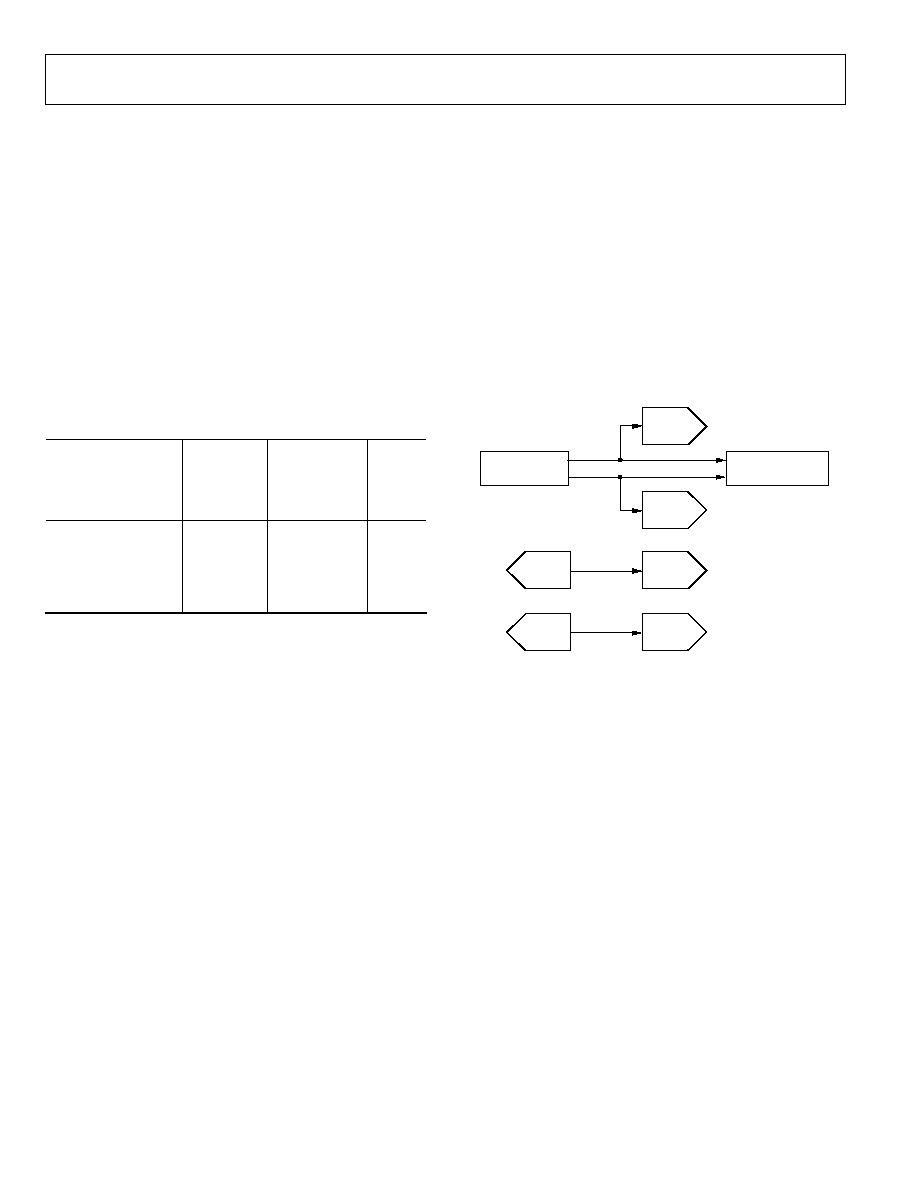
ADAU1701
Preliminary Technical Data
Rev. PrF | Page 14 of 43
INITIALIZATION
POWER-UP SEQUENCE
The ADAU1701 has a built-in power-up sequence that
initializes the contents of all internal RAMs on power-up or
when the part is brought out of reset. After RESETB (positive
edge-triggered) goes high, the contents of the internal program
boot ROM are copied to the internal program RAM memory,
the parameter RAM (all zeros) is filled with values from its
associated boot ROM, and all registers are initialized to all-
zeros. The default boot ROM program simply copies inputs to
outputs with no processing (Figure 15). In this program, serial
digital inputs 0-1 are output on DACs 0-1 and serial digital
outputs 0-1. ADCs 0-1 are output on DACs 2-3. The data
memories are also zeroed at power-up. New values should not
be written to the control port until the initialization is complete.
Table 12. Power-up time
MCLKI input
Init. time
Maximum
Program/
Parameter/
Register Boot
Time (I
2
C)
Total
3.072 MHz (64 ◊ fs)
85 ms
175 ms
260 ms
11.289 MHz (256 ◊ fs)
23 ms
175 ms
198 ms
12.288 MHz (256 ◊ fs)
21 ms
175 ms
196 ms
18.432 MHz (384 ◊ fs)
16 ms
175 ms
191 ms
24.576 MHz (512 ◊ fs)
11 ms
175 ms
186 ms
The PLL start-up time lasts for 2
18
cycles of the clock on the
MCLKI pin. This time will range from 10.7 ms for a 24.576
MHz (512 ◊ fs) input clock to 85.3 ms for a 3.072 MHz (64 ◊ fs)
input clock. This start-up time is measured from the rising edge
of RESETB. Following the PLL start-up the ADAU1701's boot
cycle takes 2048 cycles of the internal master clock (49.152
MHz at f
s
= 48 kHz). The user should avoid writing to or
reading from the ADAU1701 during this start-up time. For a
12.288 MHz input MCLK, the full initialization sequence (PLL
start-up plus boot cycle) will last approximately 22 ms. Coming
out of reset, the clock mode is immediately set by the
PLL_MODE0 and PLL_MODE1 pins. Reset is synched to the
falling edge of the internal MCLK.
Table 12 shows examples of typical times to boot the
ADAU1701 into an application's operational state, assuming a
400 kHz I
2
C clock loading a full program, parameter set, and all
registers (8.5 kB). In reality, most applications will use less than
this full amount, so the boot time (column 3) will be shorter.
RECOMMENDED PROGRAM/PARAMETER
LOADING PROCEDURE
When writing large amounts of data to the program or
parameter RAM in direct write mode, the processor core should
be disabled to prevent unpleasant noises from appearing at the
audio output.
1.
Assert bits 3 and 4 (active low) of the core control register
to mute the ADCs and DACs. This begins a volume ramp-
down.
2.
Assert bit 2 (active low) of the core control register. This
zeroes the SigmaDSP's accumulators, the data output
registers, and the data input registers.
3.
Fill the program RAM using burst-mode writes.
4.
Fill the parameter RAM using burst-mode writes.
5.
Deassert bits 2-4 of the core control register.
SDATA_IN0
ADC1
DAC3
ADC0
DAC2
SDATA_OUT0
DAC0
DAC1
Figure 15. Default Program Signal Flow
POWER REDUCTION MODES
Sections of the ADAU1701 chip can be turned on and off as
needed to reduce power consumption. These include the ADCs,
DACs, and voltage reference.
The individual analog sections can be turned off in the
Auxiliary ADC & Power Control Register (2082). By default,
the ADCs, all four DACs, and reference are enabled (all bits set
to 0). Each of these can be turned off by writing a 1 to the
appropriate bits in this register. The ADC power-down mode
will power down both ADCs and each DAC can be powered
down individually. The current savings will be about 15 mA
when the ADCs are powered down, and about 4 mA for each
powered-down DAC. The voltage reference, which is supplied
to both the ADCs and DACs, should only be powered down if
the ADCs and all four DACs are also powered down. The
reference is powered down by setting both bits 6 and 7 of the
control register.
USING THE OSCILLATOR
The ADAU1701 has an on-board oscillator that can be used to
generate the part's master clock. The oscillator is designed to
work with a 256 ◊ f
s
master clock, which will be 12.288 MHz for

Preliminary Technical Data
ADAU1701
Rev. PrF | Page 15 of 43
f
s
= 48 kHz and 11.2896 MHz for f
s
= 44.1 kHz. The crystal in
the oscillator circuit should be an AT-cut parallel resonance
device operating at its fundamental frequency. Figure 16 shows
the recommended external circuit for proper operation.
C1
100
ADAU1701
MCLKI
OSCO
C2
Figure 16. Crystal oscillator circuit
The 100 damping resistor on OSCO will give the oscillator a
voltage swing of approximately 2.2 V. The crystal's shunt
capacitance should be 7 pF. Its load capacitance should be about
18 pF, although the circuit will support values up to 25 pF. The
necessary values of the load capacitors C1 and C2 can be
calculated from the crystal's load capacitance with the equation:
stray
L
C
C
C
C
C
C
+
+
◊
=
2
1
2
1
C
stray
is the stray capacitance in the circuit and can usually be
assumed to be 2-5 pF.
OSCO should not be used to directly drive the crystal's signal to
another IC.
If the oscillator is not being used in the design it can be
powered down to save system power. This would be done in a
case where a system master clock is already available in the
system. By default, the oscillator is powered on. The oscillator
will power down when a 1 is written to bit 2 of the Oscillator
Power-down Register (2086), as shown in Table 13.
Table 13. Oscillator Power-down Register (2086)
Register Bits
Function
15:3
Reserved, set to 0
2
Oscillator power-down
1:0
Reserved, set to 0
SETTING MASTER CLOCK/PLL MODE
The ADAU1701's MCLK input feeds a PLL, which generates the
1024 ◊ f
s
clock (49.152 MHz at f
s
= 48 kHz) to run the DSP core.
In normal operation, the input to MCLK must be one of the
following: 64 ◊ f
s
, 256 ◊ f
s
, 384 ◊ f
s
, or 512 ◊ f
s
, where f
s
is the
input sampling rate. The mode is set on PLL_MODE0, and
PLL_MODE1, according to Table 14. If the ADAU1701 is set to
receive double-rate signals (by reducing the number of program
steps/sample by a factor of 2 using the core control register),
then the master clock frequencies must be either 32 ◊ f
s
, 128 ◊ f
s
, 192 ◊ f
s
, or 256 ◊ f
s
. If the ADAU1701 is set to receive quad-
rate signals (by reducing the number of program steps/sample
by a factor of 4 using the core control register), then the master
clock frequencies must be one of 16 ◊ f
s
, 64 ◊ f
s
, 96 ◊ f
s
, or 128 ◊
f
s
. On power-up, a clock signal must be present on MCLK so
that the ADAU1701 can complete its initialization routine.
Table 14. PLL Modes
MCLKI Input
PLL_MODE0
PLL_MODE1
64 ◊ f
S
0
0
256 ◊ f
S
0
1
384 ◊ f
S
1
0
512 ◊ f
S
1
1
The clock mode should not be changed without also resetting
the ADAU1701. If the mode is changed on the fly, a click or pop
may result on the outputs. The state of the PLL_MODEx pins
should be changed while RESETB is held low.
The PLL's loop filter should be connected to the PLL_LF pin.
This filter, shown in Figure 17, includes three passive
components ≠ two capacitors and a resistor. The values of these
components does not need to be exact; the tolerance can be up
to 10% for the resistor and 20% for the capacitors. The 3.3 V
signal shown in the schematic can be connected to the chip's
AVDD supply.
3.3V
475
PLL_LF
ADAU1701
56 nF
3.3 nF
Figure 17. PLL Loop Filter
VOLTAGE REGULATOR
The ADAU1701's digital voltage must be set to 1.8 V. The chip
includes an on-board voltage regulator that allows it to be used
in systems where a 1.8 V supply is not available, but 3.3 V is.
The only external components needed for this are a PNP
transistor, one resistor, and bypass capacitors. Only one pin,
VDRIVE, is necessary to support the regulator.
The recommended design for the voltage regulator is shown in
Figure 18. The 10 F and 100 nF capacitors shown in this
schematic are recommended for bypassing, but are not
necessary for operation. Each DVDD pin should have its own
100 nF bypassing capacitor, but only one bulk capacitor (10 F)
is needed for all pins. Here, 3.3 V is the main system voltage.
1.8 V is generated at the transistor's collector, which is
connected to the DVDD pins. VDRIVE is connected to the base
of the PNP transistor. If the regulator is not used in the design
VDRIVE can be tied to ground.

ADAU1701
Preliminary Technical Data
Rev. PrF | Page 16 of 43
3.3V
1 k
VDRIVE
DVDD
ADAU1701
10 uF
100 nF
Figure 18. Voltage Regulator Design
Two specifications need to be taken into consideration when
choosing a regulator transistor. First, the transistor's current
amplification factor (h
FE
or beta) should be at least 100. Second,
the transistor's collector needs to be able to dissipate the heat
generated when regulating from 3.3 V to 1.8 V. The maximum
digital current draw of the ADAU1701 is 60 mA. The equation
to determine the transistor's minimum power dissipation specs
is as follows:
(3.3 V ≠ 1.8 V) ◊ 60 mA = 90 mW
There are many transistors with these specifications available in
small packages (i.e. SOT-23 or SOT-223), such as the 2N3906 or
FZT953.
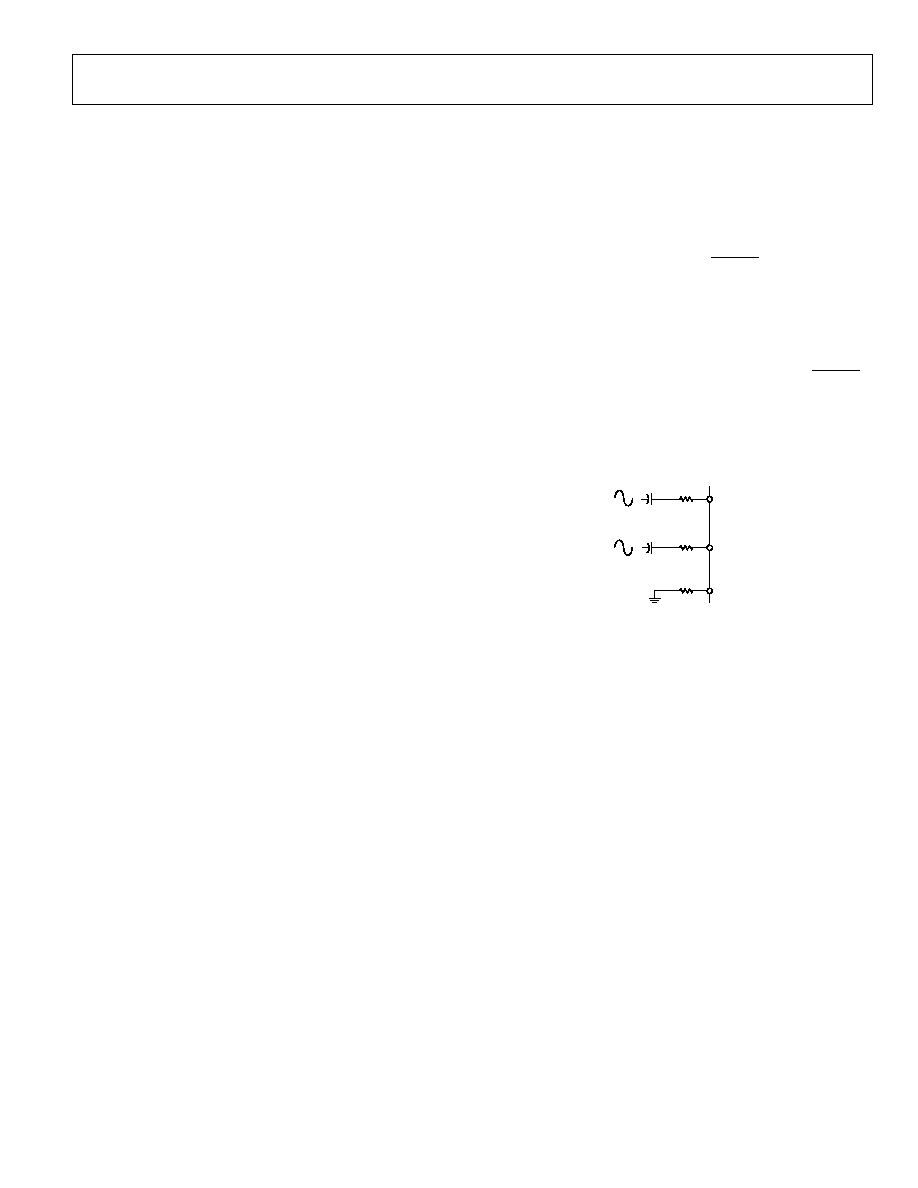
Preliminary Technical Data
ADAU1701
Rev. PrF | Page 17 of 43
TWO-CHANNEL AUDIO ADC
The ADAU1701 has a two-channel - ADC. The SNR of the
ADCs is 100 dB and the THD+N is -80 dB.
The stereo audio ADCs are current-input, so a voltage-to-
current resistor is required on the inputs. This means that the
voltage level of the input signals to the system can be set to any
level; only the input resistors need to scale to provide the proper
full-scale current input. The input pins ADC0 and ADC1, as
well as ADC_RES have an internal 2 k resistor for ESD
performance. The external resistor connected to ADC_RES sets
the full-scale current input of the ADCs. The full range of the
ADC inputs is 100 Arms and this setting is given with an
external 18 k resistor (20 k total, because it is in series with
the internal 2 k). The voltage seen directly on the ADC input
pins will be the 1.5 V common mode.
The voltage-to-current resistors connected to ADC0/1 set the
full-scale voltage input to the ADCs. With a full-scale current
input of 100 Arms, a 2.0 Vrms signal with an external 18 k
resistor (in series with the 2 k internal resistor) will give an
input using the full range of the ADC. There should not be any
need in an application to reduce the ADC's full-scale input by
increasing the value of the resistor on ADC_RES.
Either input pins ADC0 and/or ADC1 can be left unconnected
if that channel of the ADC is unused.
These calculations of resistor values all assume a 48 kHz sample
rate. The recommended input and current setting resistors will
scale directly with the sample rate because the ADCs have a
switched-capacitor input. The total value (2 k internal plus
external resistor) of the ADC_RES resistor with sample rate
f
s_new
can be calculated by:
new
s
total
f
k
R
_
48000
20
◊
=
The values of the resistors on the ADCx inputs can be
calculated by:
new
s
total
input
f
k
voltage
input
rms
R
_
_
48000
10
)
_
_
(
◊
◊
=
Figure 19 shows a typical configuration of the ADC inputs for a
2.0 Vrms input signal. The 47 F capacitors are used to ac-
couple the signals so that the inputs are biased at 1.5 V.
18 k
ADAU1701
ADC1
ADC0
ADC_RE
18 k
18 k
47 uF
47 uF
Figure 19. Audio ADC input schematic
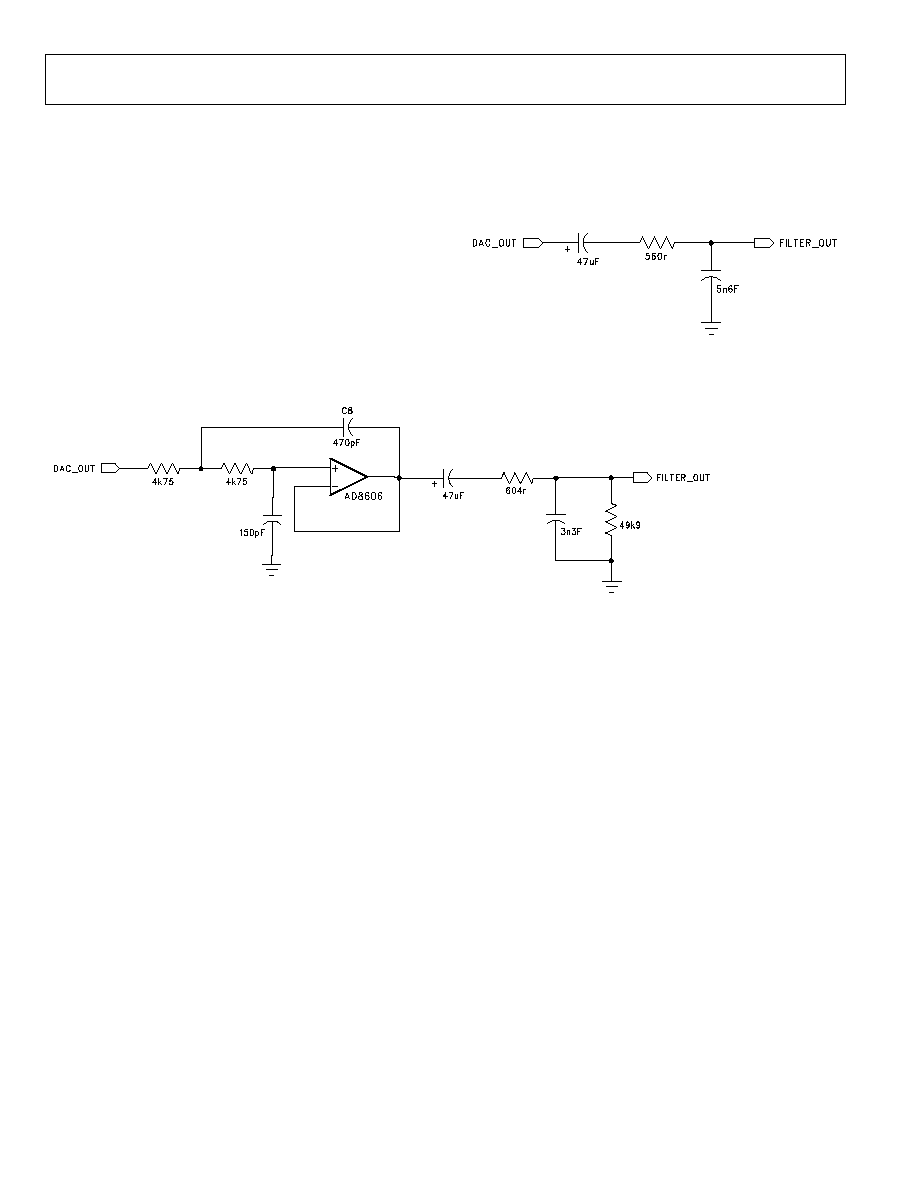
ADAU1701
Preliminary Technical Data
Rev. PrF | Page 18 of 43
FOUR-CHANNEL AUDIO DAC
The ADAU1701's main output is a four-channel - DAC. The
SNR of the DAC is 104 dB and the THD+N is -90 dB. A full-
scale output on the DACs is 0.9 Vrms (2.5 Vp-p).
The DACs are in an inverting configuration. If a signal
inversion from input to output is undesirable, this can be
reversed by using either an inverting configuration in the
output filter, or by simply inverting the signal in the SigmaDSP
program flow.
The DAC outputs can be filtered with either an active or a
passive reconstruction filter. A single-pole low-pass filter with a
50 kHz corner frequency, as shown in Figure 20, is sufficient to
filter the DAC's out-of-band noise, although an active filter may
provide better audio performance. Figure 21 shows a 3-pole
active low-pass filter that will provide a steeper roll-off and
better stop-band attenuation than the passive filter.
Figure 20. DAC output filter - passive
Figure 21. DAC output filter ≠ active
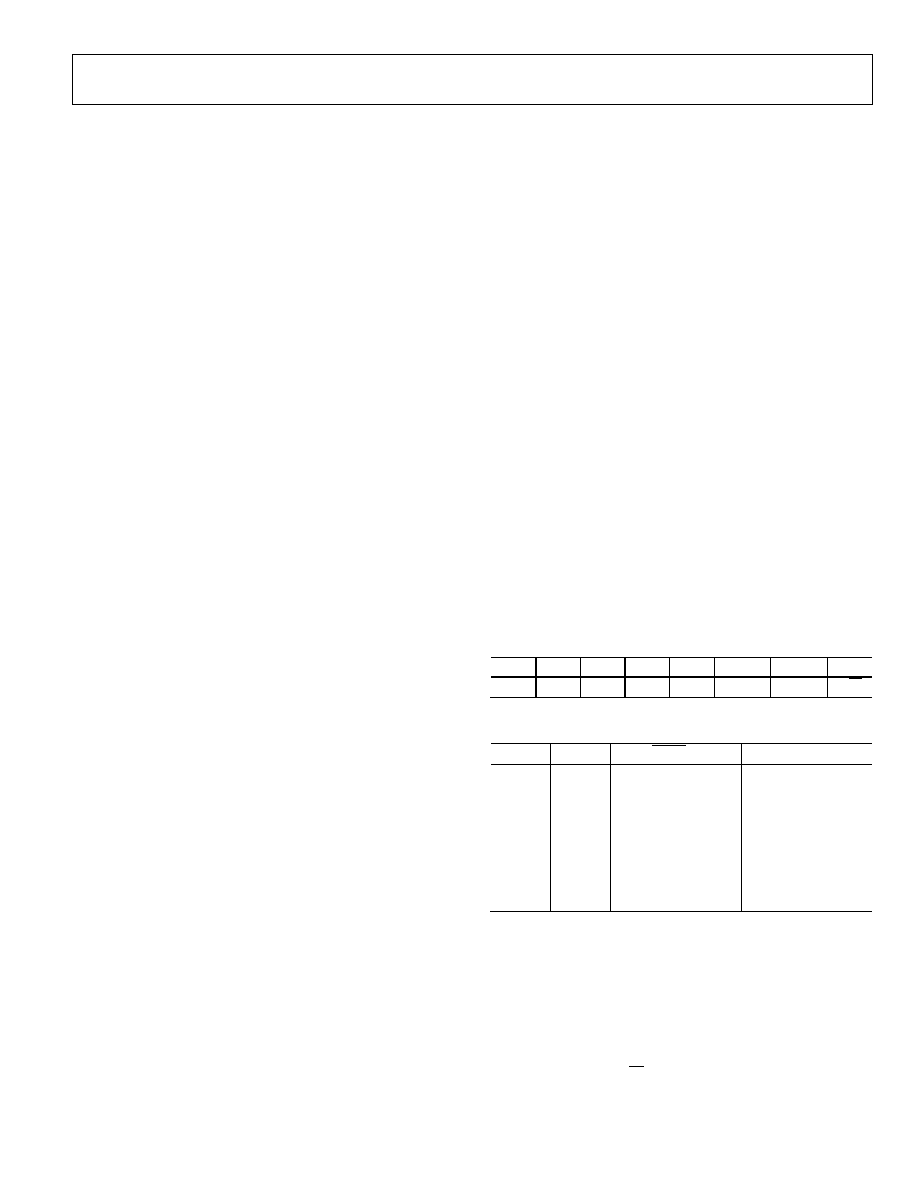
Preliminary Technical Data
ADAU1701
Rev. PrF | Page 19 of 43
CONTROL PORT
OVERVIEW
The ADAU1701 can operate in one of three control modes:
∑
I
2
C Control
∑
SPI Control
∑
Selfboot (no external controller)
The ADAU1701 has both a 4-wire SPI control port, and a 2-
wire I
2
C bus control port that can each be used to set the part's
RAMs and registers. When selfboot mode is not selected at
power-up, the part defaults to I
2
C mode, but can be put into SPI
control mode by pulling pin CLATCH/WP low three times.
When the SELFBOOT pin is set high, the ADAU1701 will load
its program, parameters, and registers settings from an external
EEPROM on start-up.
The control port is capable of full read/write operation for all of
the memories and registers. Most signal processing parameters
are controlled by writing new values to the parameter RAM
using the control port. Other functions, such as mute and
input/output mode control, are programmed by writing to the
control registers.
All addresses may be accessed in both a single-address mode or
a burst mode. A control word consists of the chip address, the
register/RAM subaddress, and the data to be written. The
number of bytes per word depends on the type of data that is
written.
The first byte of a control word (Byte 0) contains the 7-bit chip
address plus the R/W bit. The next two bytes (Bytes 1 and 2)
together form the subaddress of the memory or register
location within the ADAU1701. This subaddress needs to be
two bytes because the memories within the ADAU1701 are
directly addressable, and their sizes exceed the range of single-
byte addressing. All subsequent bytes (Bytes 3, 4, etc.) contain
the data, such as control port data or program or parameter
data. The exact formats for specific types of writes are shown in
Table 27 to Table 35.
The ADAU1701 has several mechanisms for updating signal
processing parameters in real time without causing pops or
clicks. In cases where large blocks of data need to be down-
loaded, the output of the DSP core can be halted (using Bit x of
the core control register), new data loaded, and then restarted.
This is typically done during the booting sequence at start-up or
when loading a new program into RAM. In cases where only a
few parameters need to be changed, they can be loaded without
halting the program. To avoid unwanted side effects while
loading parameters on the fly, the SigmaDSP provides the
safeload registers. The safeload registers can be used to buffer a
full set of parameters (e.g. the five coefficients of a biquad) and
then transfer these parameters into the active program within
one audio frame. The safeload mode uses internal logic to
prevent contention between the DSP core and the control port.
The control port pins are multi-functional according to which
mode in which the part is operating. details these different
functions.
I
2
C PORT
The ADAU1701 supports a 2-wire serial (I
2
C compatible)
microprocessor bus driving multiple peripherals. Two pins,
serial data (SDA) and serial clock (SCL), carry information
between the ADAU1701 and the system I
2
C master controller.
In I
2
C mode the ADAU1701 is always a slave on the bus, which
means that it will never initiate a data transfer. Each slave device
is recognized by a unique address. The address byte format is
shown in Table 15. The ADAU1701 has four possible slave
addresses: two for writing operations and two for reading.
These are unique addresses for the device and are illustrated in
Table 16. The LSB of the byte sets either a read or write
operation; Logic Level 1 corresponds to a read operation, and
Logic Level 0 corresponds to a write operation. The sixth and
seventh bits of the address are set by tying the ADDRx pins of
the ADAU1701 to logic level 0 or logic level 1. Both SDA and
SCL should have 2.2 k pull-up resistors on the lines connected
to them. The voltage on these signal lines should not be above
IOVDD (3.3 V).
Table 15. ADAU1701 Address Byte Format
Bit 0
Bit 1
Bit 2
Bit 3
Bit 4
Bit 5
Bit 6
Bit 7
0 1 1 0 1
ADDR1
ADDR0
R/W
Table 16. ADAU1701 I
2
C Addresses
ADDR1 ADDR0 Read/Write
Slave Address
0 0 0
0x68
0 0 1
0x69
0 1 0
0x6A
0 1 1
0x6B
1 0 0
0x6C
1 0 1
0x6D
1 1 0
0x6E
1 1 1
0x6F
Addressing
Initially, all devices on the I
2
C bus are in an idle state, which is
where the devices monitor the SDA and SCL lines for a start
condition and the proper address. The I
2
C master initiates a
data transfer by establishing a Start condition, defined by a
high-to-low transition on SDA while SCL remains high. This
indicates that an address/data stream will follow. All devices on
the bus respond to the start condition and shift the next eight
bits (7-bit address + R/W bit) MSB first. The device that
recognizes the transmitted address responds by pulling the data
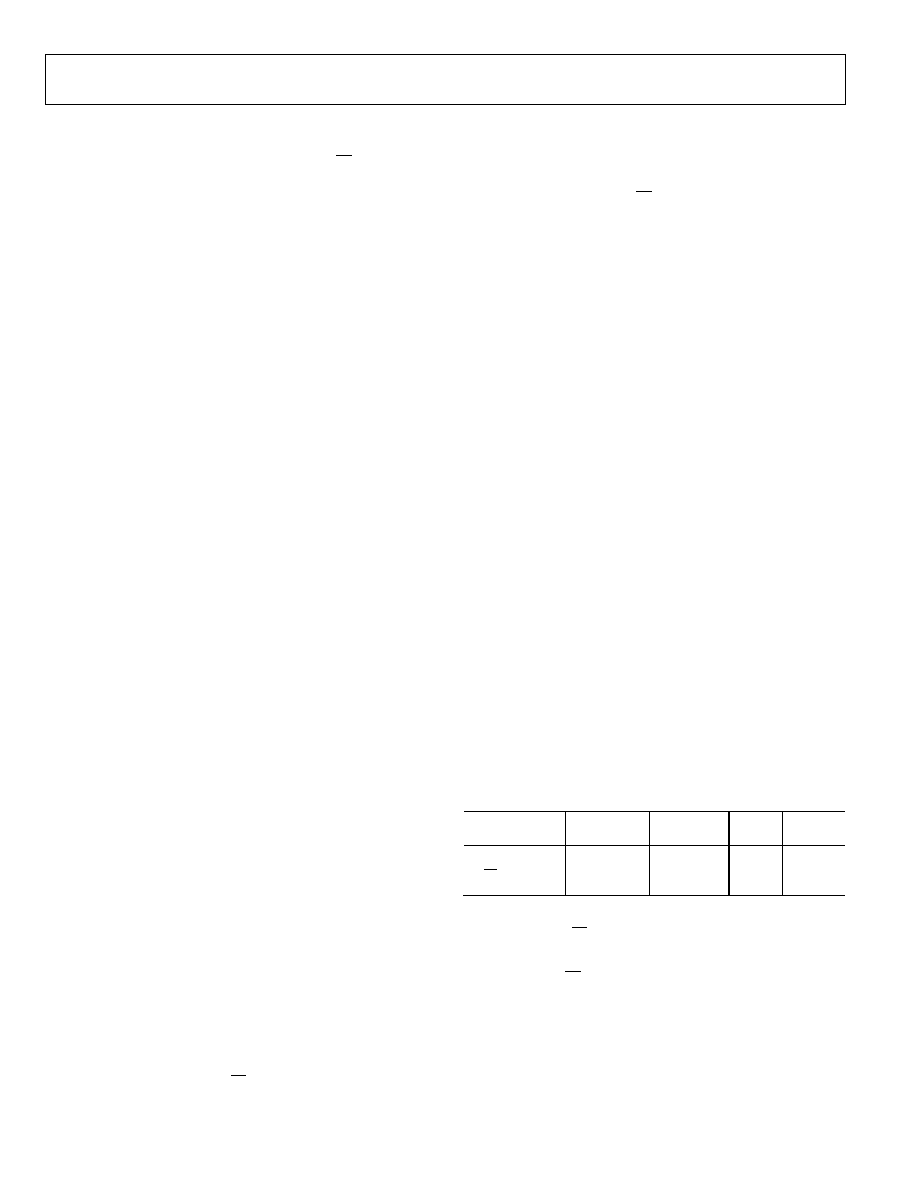
ADAU1701
Preliminary Technical Data
Rev. PrF | Page 20 of 43
line low during the ninth clock pulse. This ninth bit is known as
an acknowledge bit. All other devices withdraw from the bus at
this point and return to the idle condition. The R/W bit
determines the direction of the data. A logic 0 on the LSB of the
first byte means the master will write information to the
peripheral. A logic 1 on the LSB of the first byte means the
master will read information from the peripheral. A data
transfer takes place until a stop condition is encountered. A stop
condition occurs when SDA transitions from low to high while
SCL is held high. Figure 22 shows the timing of an I
2
C write.
Burst mode addressing, where the subaddresses are automati-
cally incremented at word boundaries, can be used for writing
large amounts of data to contiguous memory locations. This
increment happens automatically if a stop condition is not
encountered after a single-word write. The registers and
memories in the ADAU1701 range in width from one to five
bytes, so the autoincrement feature knows the mapping between
sub-addresses and the word length of the destination register
(or memory location). A data transfer is always terminated by a
stop condition.
Stop and start conditions can be detected at any stage during
the data transfer. If these conditions are asserted out of
sequence with normal read and write operations, these cause an
immediate jump to the idle condition. During a given SCL high
period, the user should only issue one start condition, one stop
condition, or a single stop condition followed by a single start
condition. If an invalid subaddress is issued by the user, the
ADAU1701 does not issue an acknowledge and returns to the
idle condition. If the user exceeds the highest subaddress while
in autoincrement mode, one of two actions will be taken. In
read mode, the ADAU1701 outputs the highest subaddress
register contents until the master device issues a no-
acknowledge, indicating the end of a read. A no-acknowledge
condition is where the SDA line is not pulled low on the ninth
clock pulse on SCL. If the highest subaddress location is
reached while in write mode, the data for the invalid byte is not
loaded into any subaddress register, a no-acknowledge is issued
by the ADAU1701, and the part returns to the idle condition.
I
2
C Read & Write Operations
Figure 24 shows the timing of a single-word write operation.
Every ninth clock, the ADAU1701 issues an acknowledge by
pulling SDA low.
Figure 25 shows the timing of a burst mode write sequence.
This figure shows an example where the target destination
registers are two bytes. The ADAU1701 knows to increment its
subaddress register every two bytes because the requested
subaddress corresponds to a register or memory area with a
2-byte word length.
The timing of a single word read operation is shown in
Figure 26. Note that the first R/W bit is still a 0, indicating a
write operation. This is because the subaddress still needs to be
written in order to set up the internal address. After the
ADAU1701 acknowledges the receipt of the subaddress, the
master must issue a repeated start command followed by the
chip address byte with the R/W set to 1 (read). This causes the
ADAU1701's SDA to turn around and begin driving data back
to the master. The master then responds every ninth pulse with
an acknowledge pulse to the ADAU1701.
Figure 27 shows the timing of a burst-mode read sequence. This
figure shows an example where the target read registers are two
bytes. The ADAU1701 knows to increment its subaddress
register every two bytes because the requested subaddress
corresponds to a register or memory area with word lengths of
two bytes. Other address ranges may have a variety of word
lengths ranging from one to five bytes; the ADAU1701 always
decodes the subaddress and sets the autoincrement circuit so
that the address increments after the appropriate number of
bytes.
SPI PORT
By default, the ADAU1701 is in I
2
C mode, but can be put into
SPI control mode by pulling CLATCH/WP low three times.
The SPI port uses a 4-wire interface, consisting of CLATCH,
CCLK, CDATA, and COUT signals. The CLATCH signal goes
low at the beginning of a transaction and high at the end of a
transaction. The CCLK signal latches CDATA on a low-to-high
transition. COUT data is shifted out of the ADAU1701 on the
falling edge of CCLK and should be clocked into the receiving
device, such as a microcontroller, on CCLK's rising edge. The
CDATA signal carries the serial input data, and the COUT
signal is the serial output data. The COUT signal remains three-
stated until a read operation is requested. This allows other SPI-
compatible peripherals to share the same readback line. All SPI
transactions follow the same basic format, shown in Table 17. A
timing diagram is shown in Figure 39. All data written should
be MSB-first.
Table 17. Generic Control Word Format
Byte 0
Byte 1
Byte 2
Byte 3
Byte 4,
etc.
chip_adr [6:0],
R/W
0000,
subadr
[11:8]
subadr[7:0] data
data
Chip Address R/W
The first byte of an SPI transaction includes the 7-bit chip
address and a R/W bit. The chip address is set by the ADR_SEL
pin. This allows two ADAU1701s to share a CLATCH signal,
yet still operate independently. When ADR_SEL0 is low, the
chip address is 0000000; when it is high, the address is 0000001.
The LSB of this first byte determines whether the SPI
transaction is a read (Logic Level 1) or a write (Logic Level 0).
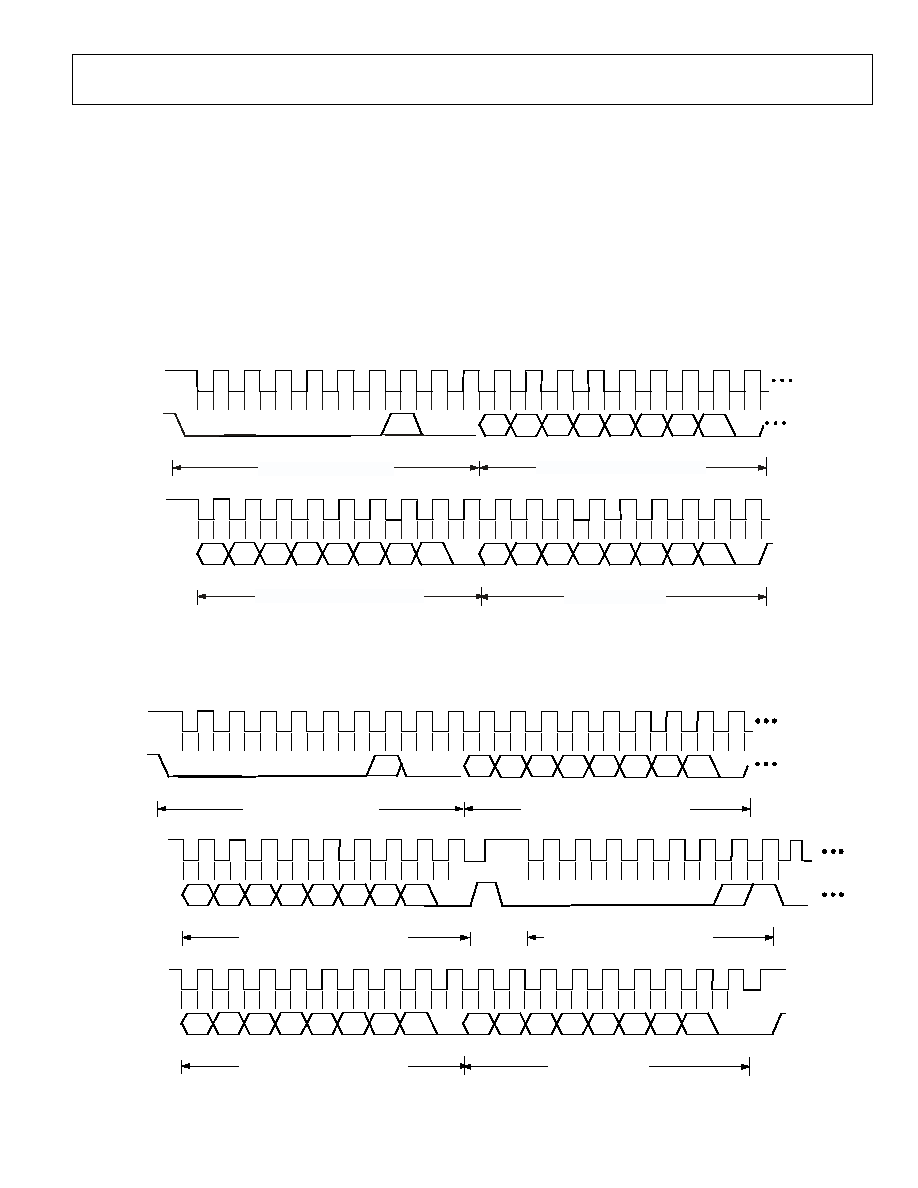
Preliminary Technical Data
ADAU1701
Rev. PrF | Page 21 of 43
Subaddress
The 12-bit Subaddress word is decoded into a location in one of
the memories or registers. This subaddress is the location of the
appropriate RAM location or register.
Data Bytes
The number of data bytes varies according to the register or
memory being accessed. In burst write mode, an initial
subaddress is given followed by a continuous sequence of data
for consecutive memory/register locations. The detailed data
format diagram for continuous-mode operation is given in the
Control Port Read/Write Data Formats section.
A sample timing diagram for a single SPI write operation to the
parameter RAM is shown in Figure 28. A sample timing
diagram of a single SPI read operation is shown in Figure 29.
The COUT pin goes from three-state to driven at the beginning
of Byte 3. In this example, Bytes 0 to 2 contain the addresses and
R/W bit, and subsequent bytes carry the data.
R/W
0
SCK
SDA
0
0
0
ADR
SEL
ACK. BY
ADAU1701
FRAME 2
SUBADDRESS BYTE 1
START BY
MASTER
ACK. BY
ADAU1701
STOP BY
MASTER
SDA
(CONTINUED)
FRAME 3
DATA BYTE 1
ACK. BY
ADAU1701
FRAME 2
SUBADDRESS BYTE 2
SCK
(CONTINUED)
FRAME 1
CHIP ADDRESS BYTE
ACK. BY
ADAU1701
0
0
Figure 22. ADAU1701 I2C Write Clocking
R/W
SCK
SDA
ADR
SEL
ACK. BY
ADAU1701
FRAME 2
SUBADDRESS BYTE 1
START BY
MASTER
SCK
(CONTINUED)
SDA
(CONTINUED)
FRAME 1
CHIP ADDRESS BYTE
ACK. BY
ADAU1701
R/W
ADR
SEL
ACK. BY
ADAU1701
REPEATED
START BY
MASTER
ACK. BY
ADAU1701
FRAME 3
SUBADDRESS BYTE 2
FRAME 4
CHIP ADDRESS BYTE
SCK
(CONTINUED)
SDA
(CONTINUED)
ACK. BY
MASTER
STOP BY
MASTER
FRAME 6
READ DATA BYTE 2
ACK. BY
MASTER
FRAME 5
READ DATA BYTE 1
Figure 23. ADAU1701 I
2
C Read Clocking
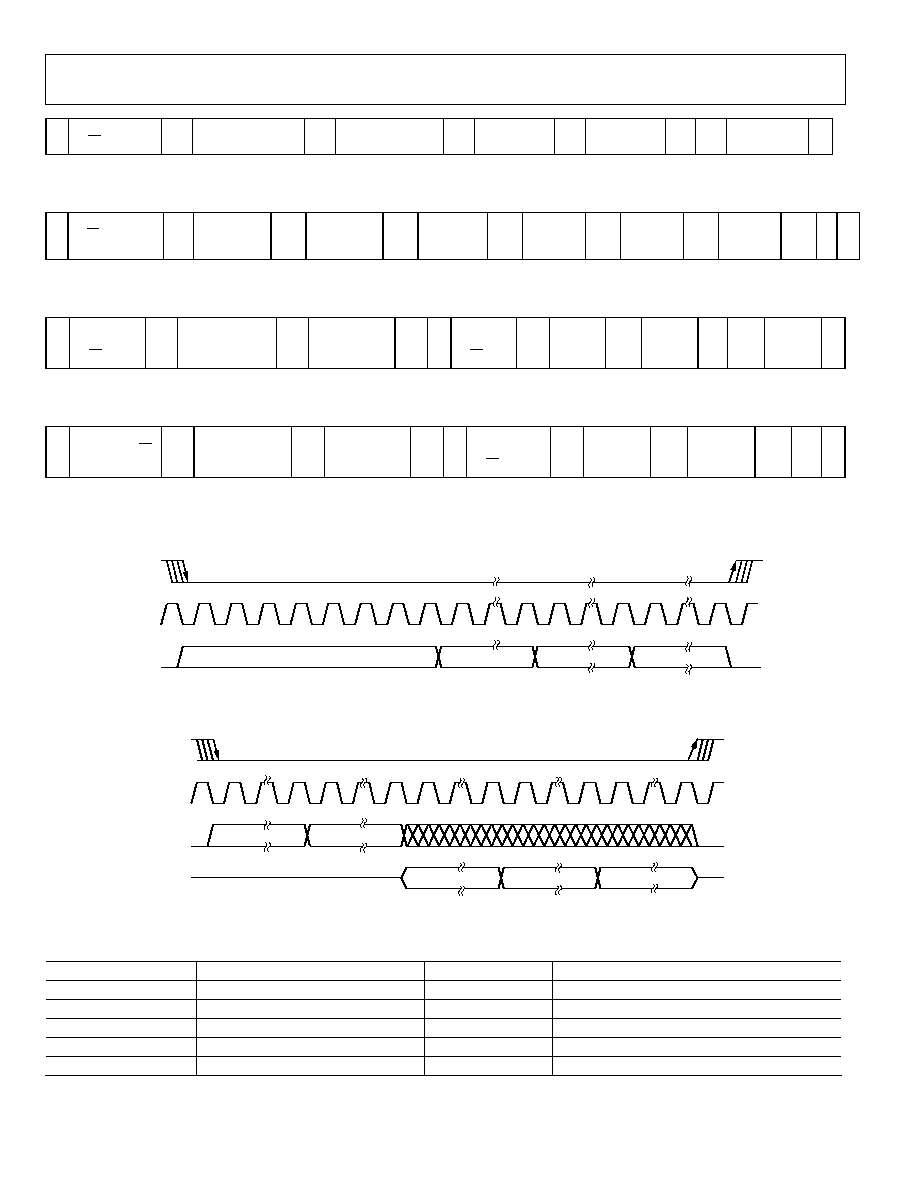
ADAU1701
Preliminary Technical Data
Rev. PrF | Page 22 of 43
S
Chip Address,
R/W = 0
AS Subaddress
High AS Subaddress
Low AS Data
Byte 1
AS
Data Byte 2
...
AS
Data Byte N
P
Figure 24. Single-Word I
2
C Write Format
S Chip
Address,
R/W = 0
AS Subaddres
s High
AS Subaddres
s Low
AS Data
Word 1,
Byte 1
AS Data
Word 1,
Byte 2
AS Data
Word 2,
Byte 1
AS Data
Word 2,
Byte 2
AS ... P
Figure 25. Burst Mode I
2
C Write Format
S
Chip
Address,
R/W = 0
AS
Subaddress
High
AS
Subaddress
Low
AS S Chip
Address,
R/W = 1
AS
Data
Byte 1
AM
Data
Byte 2
... AM Data
Byte N
P
Figure 26. Single Word I
2
C Read Format
S
Chip
Address, R/W
= 0
AS
Subaddress
High
AS
Subaddress
Low
AS S Chip
Address,
R/W = 1
AS
Data
Word 1,
Byte 1
AM
Data
Word 1,
Byte 2
AM ... P
Figure 27. Burst Mode I
2
C Read Format
S - Start Bit
P - Stop Bit
AM - Acknowledge by Master
AS - Acknowledge by Slave
CLATCH
CCLK
CDATA
BYTE 0
BYTE 1
BYTE 2
BYTE 3
04607-0-006
Figure 28. SPI Write Clocking (Single-Write Mode)
04607-0-007
CLATCH
CCLK
CDATA
COUT
BYTE 0
BYTE 1
HI-Z
DATA
DATA
DATA
HI-Z
Figure 29. SPI Read Clocking (Single-Read Mode)
Table 18. Control Port/Selfboot Pin Functions
Pin I
2
C Mode
SPI Mode
Selfboot
SCL/CCLK
SCL - input
CCLK - input
SCL - output
SDA/COUT
SDA ≠ open collector output
COUT ≠ output
SDA ≠ open collector output
ADDR1/CDATA/WB
ADDR1 - input
CDATA - input
Writeback trigger
CLATCH/WP
Unused input ≠ tie to ground or VDD
CLATCH - input
EEPROM Write Protect - open collector output
ADDR0
ADDR0 - input
ADDR0 - input
unused input ≠ tie to ground or VDD

Preliminary Technical Data
ADAU1701
Rev. PrF | Page 23 of 43
SELF BOOT
On power-up, the ADAU1701 can load a set of program and
parameters that are saved in an external EEPROM. Combined
with the auxiliary ADC and the multipurpose pins, this
eliminates the need for a microcontroller in the system. The
self-booting is accomplished by the ADAU1701 acting as a
master on the I
2
C bus on start-up, which occurs when the
Selfboot pin is set high. The ADAU1701 cannot self-boot in SPI
mode.
The maximum necessary EEPROM size is 9,248 bytes, or just
over 9 kB. This much memory will only be needed if the
program RAM (1024 ◊ 5 bytes), parameter RAM (1024 ◊ 4
bytes), and interface registers (8 ◊ 4 bytes) are each completely
full. In most applications, an 8 kB EEPROM will be sufficient.
A selfboot operation is triggered on the rising edge of RESETB
when the SELFBOOT and WP pins are set high. The
ADAU1701 reads a program, parameters, and register settings
from the EEPROM. Once the ADAU1701 has finished
selfbooting, further messages may be sent to the ADAU1701 on
the I
2
C bus, although this typically won't be necessary in a
selfbooting application. The I
2
C device address is 0x68 for a
write and 0x69 for a read in this mode. The ADDRx pins have
different functions when the chip is in this mode, so the
settings on them are ignored.
The ADAU1701 will not selfboot if WP is set low. Holding this
pin low allows the EEPROM to be programmed in-circuit. The
WP pin must be pulled low (it will normally have a resistor
pull-up) to enable writes to the EEPROM and this disables
selfboot until WP is taken high.
The ADAU1701 is a master on the I
2
C bus during selfboot and
writeback. While it would be uncommon for an application
using selfboot to also have a microcontroller in on the control
lines, care should be taken that no other device tries to write to
the I
2
C bus during selfboot or writeback. The ADAU1701
generates SCL at 8 ◊ fs, so at fs = 48 kHz SCL will run at 384
kHz. SCL has a duty cycle of 3/8 in accordance with the I
2
C
specification.
The ADAU1701 reads from EEPROM chip address 0x61. The
LSBs of the addresses of some EEPROMs are pin-configurable;
in most cases these pins should be tied low to set this address
shown here.
EEPROM format
The EEPROM data contains a sequence of messages. Each
discrete message will be one of the seven types defined in Table
19. Each message consists of a sequence of one or more bytes.
The first byte identifies the message type. Bytes are written
MSB-first. Most messages will be block write (0x01) types,
which are used for writing to the ADAU1701's program RAM,
parameter RAM, and control registers.
The body of the message following the message type should
start with a 0x00 byte ≠ this is the chip address. After this there
is always a 2-byte register/memory address field, as there are
with all other control port transactions.
WriteBack
A writeback occurs when the WB pin is triggered and data is
written to the EEPROM from the ADAU1701. This function is
typically used to save volume and other parameter settings to
the EEPROM just before power is removed from the system. A
rising edge on the WB pin triggers a writeback when the
ADAU1701 is in selfboot mode, unless a Set WB to Falling
Edge Sensitive (0x05) message was contained in the selfboot
message sequence. Only one write back will take place unless a
Set Multiple Write Back (0x04) message was contained in the
selfboot message sequence. The WP pin will be pulled low
when a writeback is triggered in order to allow writing to the
EEPROM.
The ADAU1701 is only capable of writing back the contents of
the interface registers to the EEPROM. These registers are
usually set by the DSP program, but can also be written to
directly after setting bit 6 of the
Table 19. EEPROM Message Types
Message ID
Message Type
Following Bytes
0x00 End
none
0x01 Write
2 bytes indicating
message length followed
by appropriate number
of data bytes
0x02
Delay
2 bytes for delay
0x03 No-Op
none
0x04
Set multiple write
back
none
0x05
Set WB to falling
edge sensitive
none
0x06
End and wait for
writeback
none
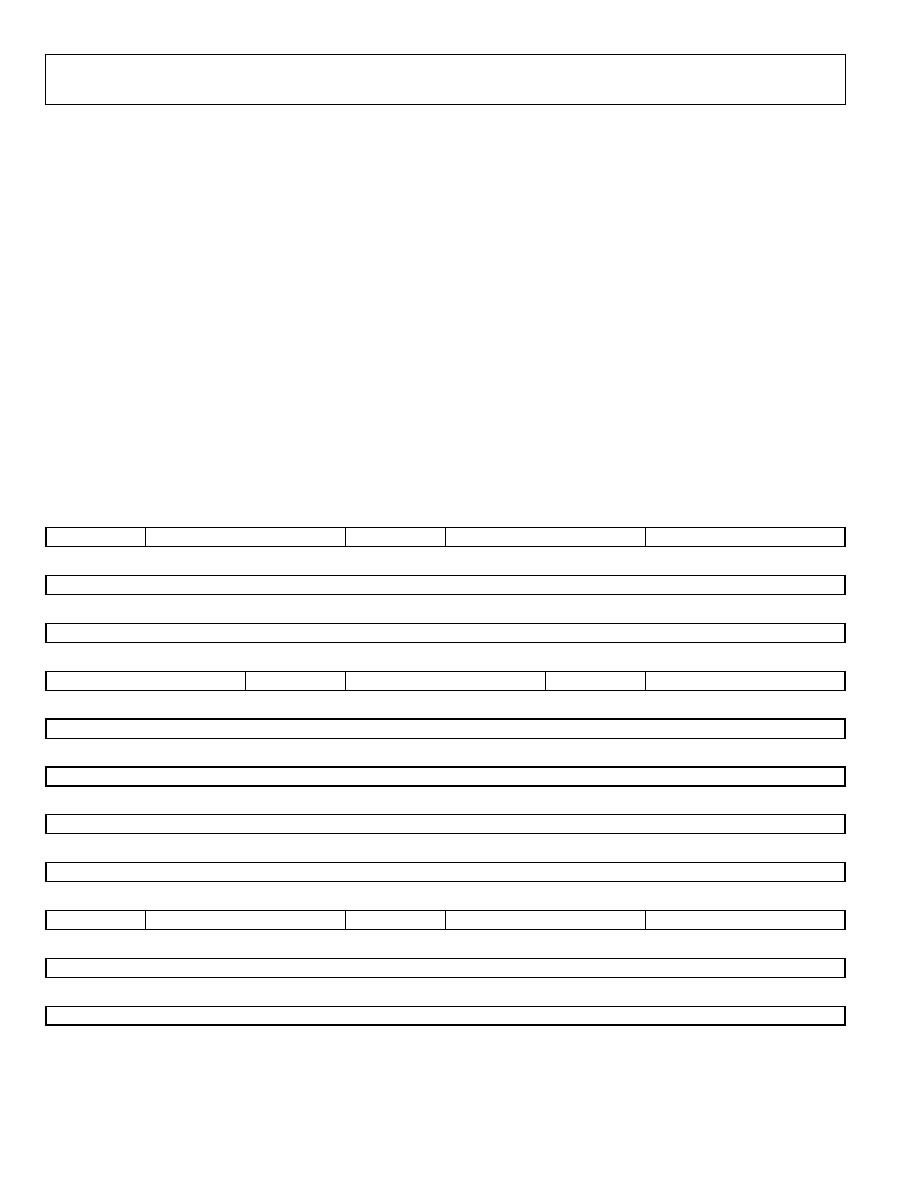
ADAU1701
Preliminary Technical Data
Rev. PrF | Page 24 of 43
DSP Core Control Register. The parameter settings that should
be saved are configured in SigmaStudio.
The writeback functions by writing data from the ADAU1701's
interface registers to the second page of the selfboot EEPROM,
addresses 32-63. Starting at EEPROM address 26 (so that the
interface register data begins at address 32), the EEPROM
should be programmed with six bytes - the Message Byte
(0x01), 2 length bytes, the chip address (0x00), the 2-byte
subaddress for the interface registers (0x08 0x00). There must
be a message to the DSP core control register to enable port
writing to the interface registers prior to the interface register
data in the EEPROM. This should be stored in EEPROM
address 0. No-op messages (0x03) may be used in-between
messages to ensure that these conditions are met.
Table 20 shows an example of what should be stored in the
EEPROM starting with EEPROM address 0. In this example,
the interface registers are first set to control port write mode
(line 1), which is followed by 18 no-op bytes (lines 2-4) so that
the interface register data will appear on page 2 of the
EEPROM. Next follows the write header (line 4) and then 32
bytes of interface register data (lines 5-8). Finally, the program
RAM data, starting at ADAU1701 address 0x04 0x00 is written
(lines 9-11). In this example, the program length is 70 words, or
350 bytes, so 332 more bytes will be included in the EEPROM
but are not shown here.
The ADAU1701 writes to EEPROM chip address 0x60. The
LSBs of the addresses of some EEPROMs are pin-configurable;
in most cases these pins should be tied low to set the address
shown here.
The maximum number of bytes that will be written back from
the ADAU1701 is 35 (eight 4-byte Interface registers plus 3
bytes of EEPROM addressing overhead). With SCL running at
384 kHz, this means that the writeback operation will take
approximately 73 s to complete after being triggered. Care
should be taken to ensure that sufficient power is available to
the system for enough time to allow a writeback to complete,
especially if the WB signal is triggered from a falling power
supply voltage.
Table 20. EEPROM Writeback Example
0x01 0x00 0x05 0x00 0x08 0x1C 0x00 0x40
Write
Length
Device Addr.
Core Control Register address
Core Control Register Data
0x03 0x03 0x03 0x03 0x03 0x03 0x03 0x03
No-Op bytes
0x03 0x03 0x03 0x03 0x03 0x03 0x03 0x03
No-Op bytes
0x03 0x03 0x01 0x00 0x23 0x00 0x08 0x00
No-Op bytes
Write
Length
Device Addr.
Interface Register Address
0x00 0x00 0x00 0x00 0x00 0x00 0x00 0x00
Interface Register Data
0x00 0x00 0x00 0x00 0x00 0x00 0x00 0x00
Interface Register Data
0x00 0x00 0x00 0x00 0x00 0x00 0x00 0x00
Interface Register Data
0x00 0x00 0x00 0x00 0x00 0x00 0x00 0x00
Interface Register Data
0x01 0x01 0x61 0x00 0x04 0x00 0x00 0x00
Write
Length
Device Addr.
Program RAM address
Program RAM data
0x00 0x00 0x01 0x00 0x00 0x00 0xE8 0x01
Program RAM data
0x00 0x00 0x00 0x00 0x01 0x00 0x08 0x00
Program RAM data (continues for 332 more bytes)
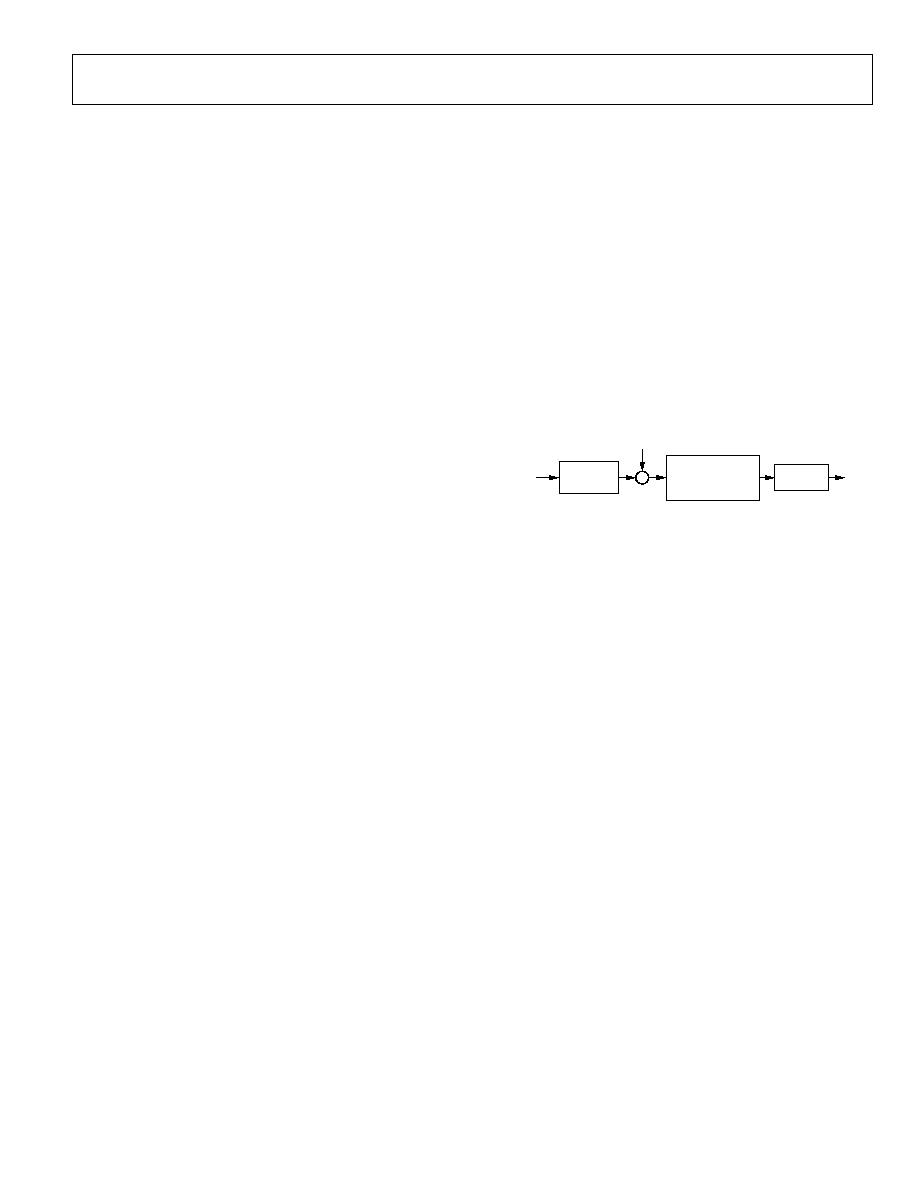
Preliminary Technical Data
ADAU1701
Rev. PrF | Page 25 of 43
SIGNAL PROCESSING
OVERVIEW
The ADAU1701 is designed to provide all signal processing
functions commonly used in stereo or multichannel playback
systems. The signal processing flow is designed using the ADI-
supplied SigmaStudio software, which allows graphical entry
and real-time control of all signal processing functions.
Many of the signal processing functions are coded using full,
56-bit double-precision arithmetic. The input and output word
lengths are 24 bits. Four extra headroom bits are used in the
processor to allow internal gains up to 24 dB without clipping.
Additional gains can be achieved by initially scaling down the
input signal in the signal flow.
The signal processing blocks can be arranged in a custom pro-
gram that can be loaded to the ADAU1701's RAM. The
available signal processing blocks are explained in the following
sections.
NUMERIC FORMATS
It is common in DSP systems to use a standardized method of
specifying numeric formats. Fractional number systems are
specified by an A.B format, where A is the number of bits to the
left of the decimal point and B is the number of bits to the right
of the decimal point.
The ADAU1701 uses the same numeric format for both the
coefficient values (stored in the parameter RAM) and the signal
data values. The format is as follows:
Numerical Format: 5.23
Range: ≠16.0 to (+16.0 - 1 LSB)
Examples:
1000 0000 0000 0000 0000 0000 0000 = ≠16.0
1110 0000 0000 0000 0000 0000 0000 = ≠4.0
1111 1000 0000 0000 0000 0000 0000 = ≠1.0
1111 1110 0000 0000 0000 0000 0000 = ≠0.25
1111 1111 1111 1111 1111 1111 1111 = (1 LSB below 0.0)
0000 0000 0000 0000 0000 0000 0000 = 0.0
0000 0010 0000 0000 0000 0000 0000 = 0.25
0000 1000 0000 0000 0000 0000 0000 = 1.0
0010 0000 0000 0000 0000 0000 0000 = 4.0
0111 1111 1111 1111 1111 1111 1111 = (16.0 ≠ 1 LSB).
The serial port accepts up to 24 bits on the input and is sign-
extended to the full 28 bits of the core. This allows internal
gains of up to 24 dB without encountering internal clipping.
A digital clipper circuit is used between the output of the DSP
core and the outputs (see Figure 30). This clips the top four bits
of the signal to produce a 24-bit output with a range of 1.0
(minus 1 LSB) to ≠1.0.
4-BIT SIGN EXTENSION
DATA IN
SERIAL PORT
1.23
5.23
SIGNAL PROCESSING
(5.23 FORMAT)
DIGITAL
CLIPPER
5.23
1.23
04607-0-005
Figure 30. Numeric Precision and Clipping Structure
PROGRAMMING
On power-up, the ADAU1701's default program passes the
unprocessed input signals to the outputs (Figure 15), but the
outputs are muted by default (see Power-Up Sequence section).
There are 1,024 instruction cycles per audio sample, resulting in
an internal clock rate of 49.152 MHz (for f
s
= 48 kHz). This DSP
runs in a stream-oriented manner, meaning all 1,024
instructions are executed each sample period. The ADAU1701
may also be set up to accept double or quad-speed inputs by
reducing the number of instructions/sample, which can be set
in the core control register.
The part can be programmed easily using SigmaStudio, a
graphical tool provided by Analog Devices. No knowledge of
writing line-level DSP code is required.

ADAU1701
Preliminary Technical Data
Rev. PrF | Page 26 of 43
RAMS AND REGISTERS
Table 21. Control Port Addresses
SPI/ I
2
C Subaddress
Register/RAM Name
Read/Write Word Length
0≠1023 (0x0000≠0x03FF)
Parameter RAM
Write: 4 Bytes, Read: 4 Bytes
1024≠2047 (0x0400-0x07FF)
Program RAM
Write: 5 Bytes, Read: 5 Bytes
2048-2055 (0x0800-0x0807)
Interface Registers 0 - 7
Read: 4 bytes, Write: 4 bytes
2056 (0x0808)
GPIO Pin Setting Register
Read: 2 bytes, Write: 2 bytes
2057-2060 (0x0809-0x080C)
Aux ADC Data Registers
Read: 2 bytes, Write: 1 byte
2064≠2068 (0x080D-0x0814)
Safeload Data Registers 0 ≠ 4
Write: 5 Bytes, Read: N/A
2069≠2073 (0x0815-0x0819)
Safeload Address Registers 0 - 4
Write: 2 Bytes, Read: N/A
2074-2075 (0x081A-0x081B)
Data Capture Registers 0≠1
Write: 2 Bytes, Read: 3 Bytes
2076 (0x081C)
DSP Core Control Register
Write: 2 Bytes, Read: 2 Bytes
2077 (0x081D)
Reserved ≠ do not write
Write: 1 Byte, Read: 1 Byte
2078 (0x081E)
Serial Output Control Register
Write: 2 Bytes, Read: 2 Bytes
2079 (0x081F)
Serial Input Control Register
Write: 1 Byte, Read: 1 Byte
2080-2081 (0x0820-0x0821)
Multi-Purpose Pin Configuration Registers 0 ≠ 1
Write: 3 Bytes, Read: 3 Bytes
2082 (0x0822)
Auxiliary ADC & Power Control Register
Write: 2 Bytes, Read: 2 Bytes
2083 (0x0823)
Reserved ≠ do not write
Write: 2 Bytes, Read: 2 Bytes
2084 (0x0824)
Auxiliary ADC Enable Register
Write: 2 Bytes, Read: 2 Bytes
2085 (0x0825)
Reserved ≠ do not write
Write: 2 Bytes, Read: 2 Bytes
2086 (0x0826)
Oscillator Power-down Register
Write: 2 Bytes, Read: 2 Bytes
Table 22. RAM Read/Write Modes
Memory
Size
Address Range
Read
Write
Write Modes
Parameter RAM
1024 ◊ 28
0≠1023
Yes
Yes
Direct Write
1
, Safeload Write
Program RAM
1024 ◊ 40
1024≠2047
Yes
Yes
Direct Write
1
1
Internal registers should be cleared first to avoid clicks/pops.
CONTROL PORT ADDRESSING
Table 21 shows the addressing of the ADAU1701's RAM and
register spaces. The address space encompasses a set of registers
and two RAMs: one each for holding signal processing
parameters and holding the program instructions. The program
and parameter RAMs are initialized on power-up from on-
board boot ROMs (see Power-Up Sequence section).
Table 22 shows the sizes and available writing modes of the
parameter and program RAMs.
All RAMs and registers have a default value of all zeros, except
for the program RAM which is loaded with the default program
as described in the Initialization section.
PARAMETER RAM
The parameter RAM is 28 bits wide and occupies Addresses 0 to
1023. The parameter RAM is initialized to all zeros on power-
up. The data format of the parameter RAM is twos complement
5.23. This means that the coefficients may range from +16.0
(minus 1 LSB) to ≠16.0, with 1.0 represented by the binary word
0000 1000 0000 0000 0000 0000 0000 or hexadecimal word
0x00 0x80 0x00 0x00.
The parameter RAM can be written and read using one of the
two following methods.
Direct Read/Write
This method allows direct access to the program and parameter
RAMs. This mode of operation is normally used during a
complete new load of the RAMs, using burst-mode addressing.
The clear registers bit in the core control register should be set
to 0 using this mode to avoid any clicks or pops in the outputs.
Note that it is also possible to use this mode during live
program execution, but since there is no handshaking between
the core and the control port, the parameter RAM will be
unavailable to the DSP core during control writes, resulting in
clicks and pops in the audio stream.
Safeload Write
Up to five safeload registers can be loaded with parameter RAM
address/data. The data is then transferred to the requested
address when the RAM is not busy. This method can be used
for dynamic updates while live program material is playing
through the ADAU1701. For example, a complete update of one
biquad section can occur in one audio frame, while the RAM is
not busy. This method is not available for writing to the
program RAM or control registers.
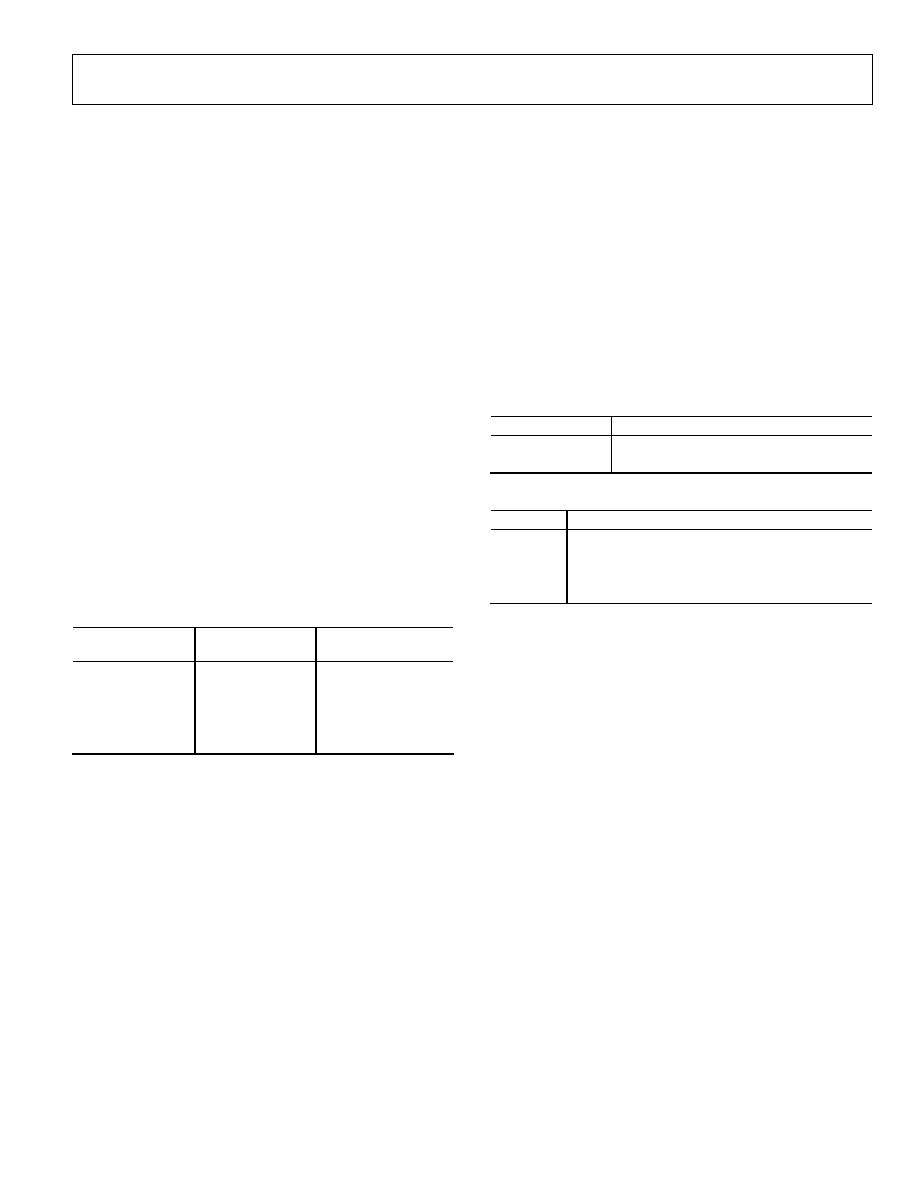
Preliminary Technical Data
ADAU1701
Rev. PrF | Page 27 of 43
The following sections discuss these two options in more detail.
SAFELOAD REGISTERS
Many applications require real-time microcontroller control of
signal processing parameters, such as filter coefficients, mixer
gains, multi-channel virtualizing parameters, or dynamics
processing curves. One example is that to prevent instability
from occurring, all of the parameters of a biquad filter must be
updated at the same time. Otherwise, the filter could execute for
one or two audio frames with a mix of old and new coefficients.
This mix could cause temporary instability, leading to transients
that could take a long time to decay. To eliminate this problem,
the ADAU1701 can simultaneously load a set of five 28-bit
values to the desired parameter RAM address. Five registers are
used because a biquad filter uses five coefficients, and it is
desirable to be able to do a complete biquad update in one
transaction.
The first step in performing a safeload is writing the parameter
address to one of the Safeload Address Registers (2069 ≠ 2073).
The 10-bit data word that should be written is the address to
which the safeload is being performed. After the Safeload
Address Register is set, then the 28-bit data word can be written
to the corresponding Safeload Data Register (2064 ≠ 2068). The
data formats for these writes are detailed in Table 35 and Table
36. Table 23 shows how each of the five Address Registers map
to their corresponding Data Registers.
Table 23. Safeload Address & Data Register Mapping
Safeload Register Safeload Address
Register
Safeload Data
Register
0 2069
2064
1 2070
2065
2 2071
2066
3 2072
2067
4 2073
2068
Once the address and data registers are loaded, the initiate
safeload transfer bit in the core control register should be set to
initiate the loading into RAM. Each safeload register will take
one of the 1,024 core instructions to load into the parameter
RAM. Total program lengths should be limited to 1,019 cycles
(1,024 - 5) to ensure that the SigmaDSP core has at least five
free cycles to perform the safeloads. It is guaranteed that the
safeload will have occurred within one LRCLK period (21 s at
f
s
= 48 kHz) of the initiate safeload transfer bit being set.
The safeload logic automatically sends only those safeload
registers that have been written to since the last safeload
operation. For example, if only two parameters are to be sent,
only two of the five safeload registers must be written. When
the initiate safeload transfer bit is asserted, only those two
registers are sent; the other three registers are not sent to the
RAM and can still hold old or invalid data.
DATA CAPTURE REGISTERS
The ADAU1701's data capture feature allows the data at any
node in the signal processing flow to be sent to one of two
control port-readable registers. This can be used to monitor and
display information about internal signal levels or
compressor/limiter activity.
For each of the data capture registers, a capture count and a
register select must be set. The capture count is a number
between 0 and 1023 that corresponds to the program step
number where the capture will occur. The register select field
programs one of four registers in the DSP core that will be
transferred to the data capture register when the program
counter equals the capture count. The register select field
selections are shown in Table 24.
Table 24. Data Capture Control Registers (2074-2075)
Register Bits
Function
12:2
11-Bit Program Counter Address
1:0
Register Select
Table 25. Data Capture Output Register Select
Setting Register
00
Multiplier X Input (Mult_X_input)
01
Multiplier Y Input (Mult_Y_input)
10
Multiplier-Accumulator Output (MAC_out)
11
Accumulator Feedback (Accum_fback)
The capture count and register select bits are set by writing to
one of the eight data capture registers at register addresses
2074: Control Port Data Capture Setup Register 0
2075: Control Port Data Capture Setup Register 1
The captured data is in 5.19 two's complement data format. The
four LSBs are truncated from the internal 5.23 data word.
The data that must be written to set up the data capture is a
concatenation of the 11-bit program count index with the 2-bit
register select field. The capture count and register select values
that correspond to the desired point to be monitored in the
signal processing flow can be found in a file output from the
program compiler. The capture registers can be accessed by
reading from locations 2074 and 2075. The format for reading
and writing to the data capture registers can be seen in Table 33
and Table 34.

ADAU1701
Preliminary Technical Data
Rev. PrF | Page 28 of 43
DSP CORE CONTROL REGISTER
The controls in this register set the operation of the
ADAU1701's DSP core.
Table 26. DSP Core Control Register (2076)
Register Bits
Function
15:14 Reserved
13:12
GPIO Debounce control
00 = 20ms
01 = 40ms
10 = 10ms
11 = 5ms
11:9 Reserved
8
Aux ADC Data registers control port write mode
7
GPIO Pin Setting register control port write
mode
6
Interface registers control port write mode
5
Initiate Safeload Transfer
4
Mute ADCs, active low
3
Mute DACs, active low
2
Clear Internal Registers to All Zeros, active low
1:0
Sample Rate
00 = 1◊ (1024 instructions, 48 kHz)
01 = 2◊ (512 instructions, 96 kHz)
10 = 4◊ (256 instructions, 192 kHz)
00 = reserved
GPIO Debounce control (Bits 13:12)
Set debounce time of multipurpose pins set as GPIO inputs.
Aux ADC Data registers control port write mode (Bit 8)
Setting this bit allows data to be written directly to the Aux
ADC Data registers (2057-2060) from the control port. When
set, the Aux ADC Data registers will no longer respond to
settings on the multi-purpose pins.
GPIO Pin Setting register control port write mode (Bit 7)
When this bit is set, the GPIO Pin Setting register (2056) can be
written to directly from the control port and this register will no
longer respond to input settings on the multi-purpose pins.
Interface registers control port write mode (Bit 6)
When this bit is set, data can be written directly to the Interface
registers (2048-2055) from the control port. In that state, the
Interface registers will not be written from the SigmaDSP
program.
Initiate Safe Transfer to Parameter RAM (Bit 5)
Setting this bit to 1 initiates a safeload transfer to the parameter
RAM. This bit is automatically cleared when the operation is
completed. There are five safeload register pairs (address/data);
only those registers that have been written since the last
safeload event are transferred to the parameter RAM.
Mute ADCs (Bit 4)
This bit will mute the output of the ADCs. The bit defaults to 0
and is active-low, so it must be set to 1 in order to pass audio
from the ADCs.
Mute DACs (Bit 3)
This bit will mute the output of the DACs. The bit defaults to 0
and is active-low, so it must be set to 1 in order to pass audio
from the DACs.
Clear Internal Registers to All Zeros (Bit 2)
This bit defaults to 0 and is active low. This bit needs to be set to
1 in order for a signal to pass through the SigmaDSP core.
Sample Rate (Bits 1:0)
These bits set the number of DSP instructions for every sample
and the sample rate at which the ADAU1701 will operate. At the
default setting of 1◊ there will be 1024 instructions per audio
sample. This setting should be used with sample rates such as
48 kHz and 44.1 kHz.
In the 2◊ setting the number of instructions per frame will be
halved to 512 and the ADCs and DACs will nominally run at a
96 kHz sample rate.
At a 4◊ setting there will be 256 instructions per cycle and the
converters will run at a 192 kHz sample rate.
INTERFACE REGISTERS
The interface registers are used in self-boot mode to save
parameters that need to be written to the external EEPROM.
The ADAU1701 will then recall these parameters from the
EEPROM after the next reset or power-up. This way, system
parameters such as volume and EQ settings can be saved during
power-down and recalled when the system is next turned on.
There are eight 32-bit interface registers, which allows for eight
28-bit (plus zero-padding) parameters to be saved. The
parameters that will be saved in these registers are set in the
graphical programming tools. These registers are updated with
their corresponding parameter RAM data once per sample
period.
An edge, which can be set to be either rising or falling, triggers
the ADAU1701 to write the current contents of the interface
registers to the EEPROM. See more information in the Self boot
section.
The user can write directly to the interface registers after bit 6 in
the DSP core control register has been set. In this mode, the
data in the registers is written from the control port and not
from the DSP core.
CONTROL PORT READ/WRITE DATA FORMATS
The read/write formats of the control port are designed to be
byte-oriented. This allows for easy programming of common
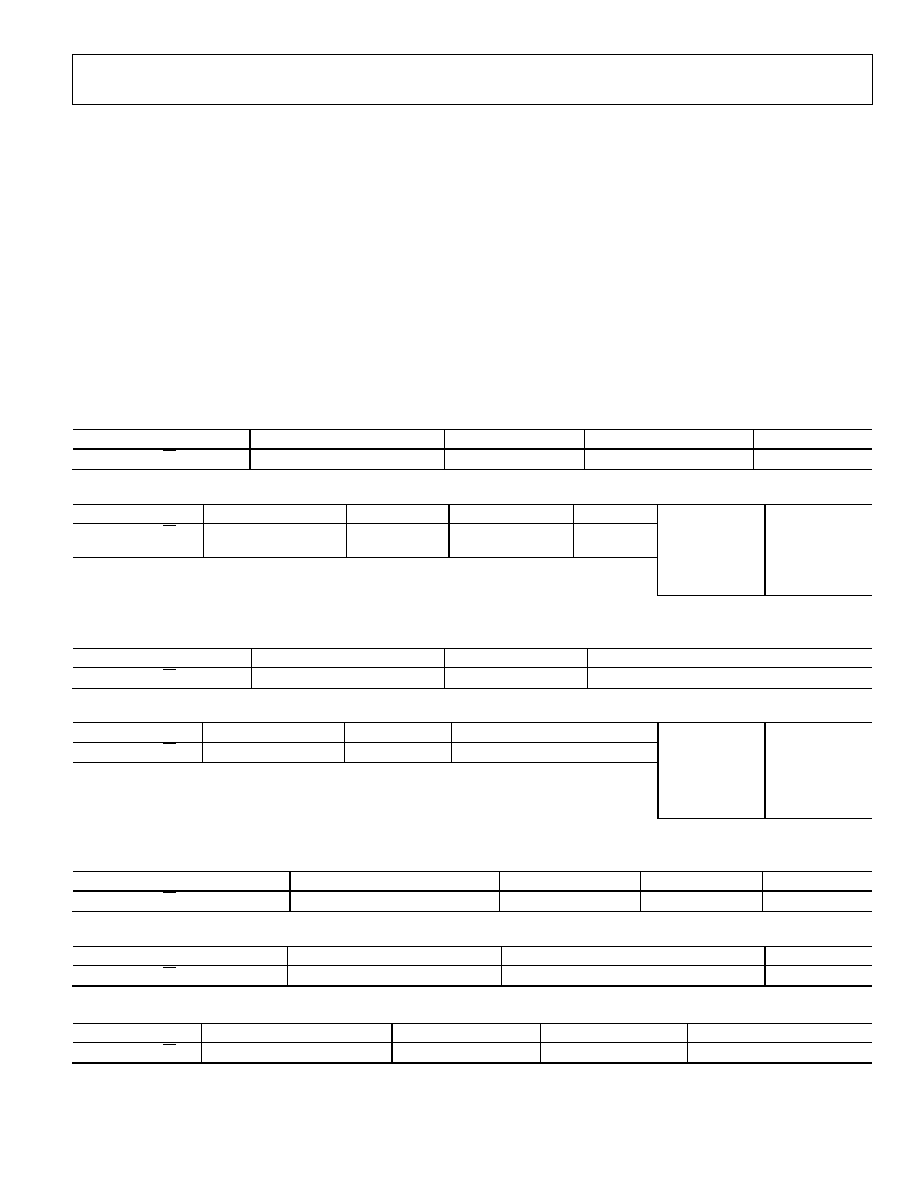
Preliminary Technical Data
ADAU1701
Rev. PrF | Page 29 of 43
microcontroller chips. In order to fit into a byte-oriented
format, 0s are appended to the data fields before the MSB in
order to extend the data word to the next multiple of eight bits.
For example, 28-bit words written to the parameter RAM are
appended with four leading 0s in order to reach 32 bits
(4 bytes); 40-bit words written to the program RAM are not
appended with any 0s because it is already a full 5 bytes. These
zero-extended data fields are appended to a 3-byte field
consisting of a 7-bit chip address, a read/write bit, and an 11-bit
RAM/register address. The control port knows how many data
bytes to expect based on the address that is received in the first
three bytes.
The total number of bytes for a single-location write command
can vary from four bytes (for a control register write), to eight
bytes (for a program RAM write). Burst mode may be used to
fill contiguous register or RAM locations. A burst mode write is
done by writing the address and data of the first RAM/register
location to be written. Rather than ending the control port
transaction (by issuing a stop command in I
2
C mode or by
bringing the CLATCH signal high in SPI mode, after the data
word), as would be done in a single-address write, the next data
word can be written immediately without first writing its
specific address. The ADAU1701 control port auto-increments
the address of each write, even across the boundaries of the
different RAMs and registers. Table 28 and Table 30 show
examples of burst mode writes.
Table 27. Parameter RAM Read/Write Format (Single Address)
Byte 0
Byte 1
Byte 2
Byte 3
Bytes 4≠6
chip_adr [6:0], W/R
00000, param_adr[10:8]
param_adr[7:0]
0000, param[27:24]
param [23:0]
Table 28. Parameter RAM Block Read/Write Format (Burst Mode)
Byte 0
Byte 1
Byte 2
Byte 3
Bytes 4≠6
Byte 7
Byte 11
chip_adr [6:0], W/R 00000,
param_adr[10:8]
param_adr[7:0] 0000,
param[27:24] param[23:0] Byte 8
Byte 12
Byte 9
Byte 13
Byte 10
Byte 14
<--param_adr-->
param_adr + 1
param_adr + 2
Table 29. Program RAM Read/Write Format (Single Address)
Byte 0
Byte 1
Byte 2
Bytes 3≠7
chip_adr [6:0], W/R
0000, prog_adr[11:8]
prog_adr[7:0]
prog[39:0]
Table 30. Program RAM Block Read/Write Format (Burst Mode)
Byte 0
Byte 1
Byte 2
Byte 3-7
Byte 8
Byte 13
chip_adr [6:0], W/R
0000, prog_adr[11:8]
prog_adr[7:0]
prog[39:0]
Byte 9
Byte 14
Byte 10
Byte 15
Byte 11
Byte 16
Byte 12
Byte 17
<--prog_adr-->
prog_adr +1
prog_adr +2
Table 31. Control Register Read/Write Format (Core, Serial Out 0, Serial Out 1)
Byte 0
Byte1
Byte 2
Byte 3
Byte 4
chip_adr [6:0], W/R
0000, reg_adr[11:8]
reg_adr[7:0]
data[15:8]
data[7:0]
Table 32. Control Register Read/Write Format (RAM Configuration, Serial Input)
Byte 0
Byte1
Byte 2
Byte 3
chip_adr [6:0], W/R
0000, reg_adr[11:8]
reg_adr[7:0]
data[7:0]
Table 33. Data Capture Register Write Format
Byte 0
Byte 1
Byte 2
Byte 3
Byte 4
chip_adr [6:0], W/R
0000, data_capture_adr[11:8]
data_capture_adr[7:0]
000, progCount[10:6]
1
progCount[5:0]
1
, regSel[1:0]
2
1
ProgCount[10:0] = value of program counter where trap occurs (the table of values is generated by the program compiler).
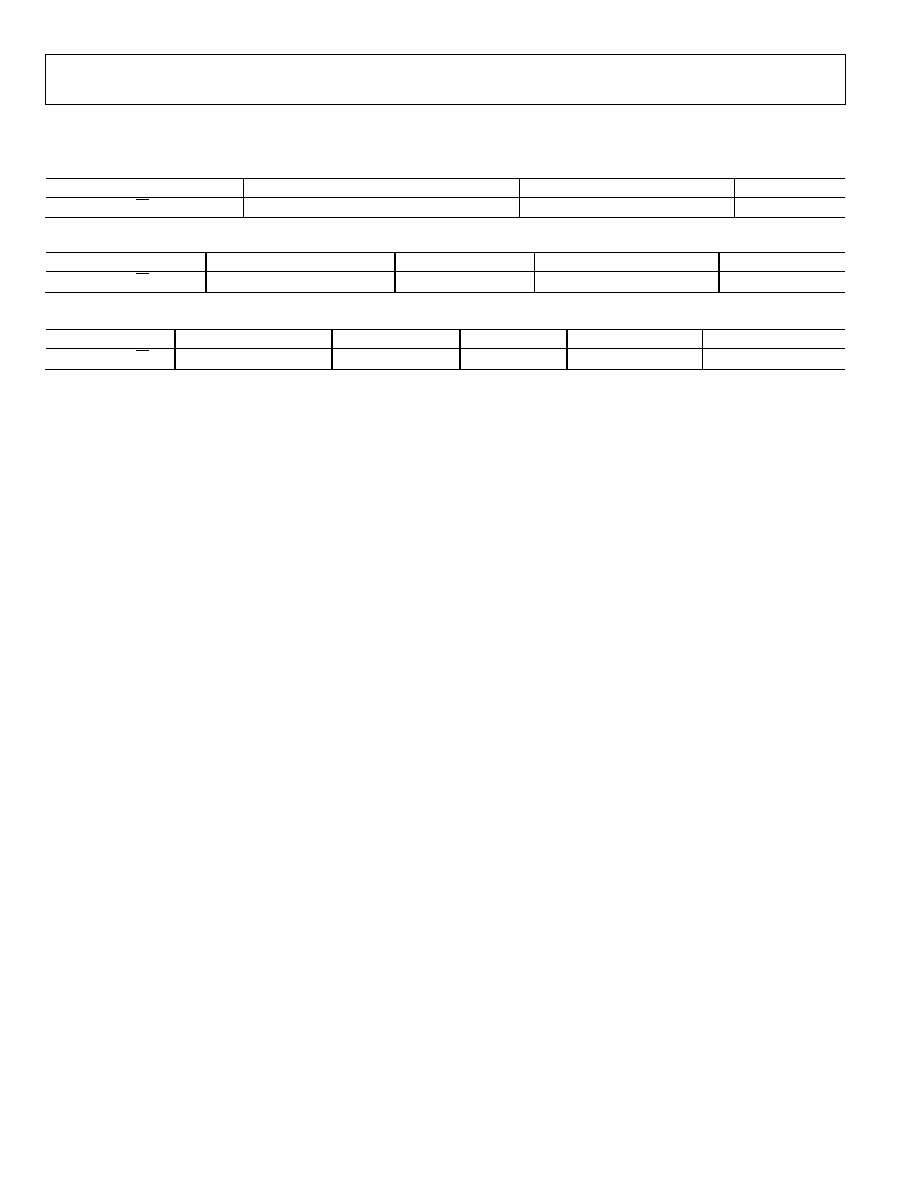
ADAU1701
Preliminary Technical Data
Rev. PrF | Page 30 of 43
2
RegSel[1:0] selects one of four registers (see Data Capture Registers section).
Table 34. Data Capture (Control Port Readback) Register Read Format
Byte 0
Byte 1
Byte 2
Bytes 3≠5
chip_adr [6:0], W/R
0000, data_capture_adr[11:8]
data_capture_adr[7:0]
data[23:0]
Table 35. Safeload Address Register Write Format
Byte 0
Byte 1
Byte 2
Byte 3
Byte 4
chip_adr [6:0], W/R
0000, safeload_adr[11:8]
safeload_adr[7:0]
000000, param_adr[9:8]
param_adr[7:0]
Table 36. Safeload Data Register Write Format
Byte 0
Byte 1
Byte 2
Byte 3
Byte 4
Bytes 5≠7
chip_adr [6:0], W/R
0000, safeload_adr[11:8]
safeload_adr[7:0]
00000000
0000, data[27:24]
data[23:0]
DATA RAM
The ADAU1701's data RAM is used to store audio data words
for processing. For the most part, this process is transparent to
the user; the user cannot even directly address this RAM space
from the control port. The size of the data RAM is 2 k words.
The user's only concern should be when implementing blocks
that utilize large amounts of data RAM space, such as delays.
The SigmaDSP core processes delay times in one-sample
increments, so the total pool of delay available to the user will
equal 2048 ◊ the sample period. For fs = 48 kHz, this means
that the pool of available delay is a maximum of about 43 ms. In
practice, this much data memory will not be available to the
user, though, because every block in a design will use a few data
memory locations for its processing. In most DSP programs this
will not significantly impact the total delay time. The
SigmaStudio compiler will manage the data RAM and will
indicate if the number of addresses used has exceeded the
maximum available.
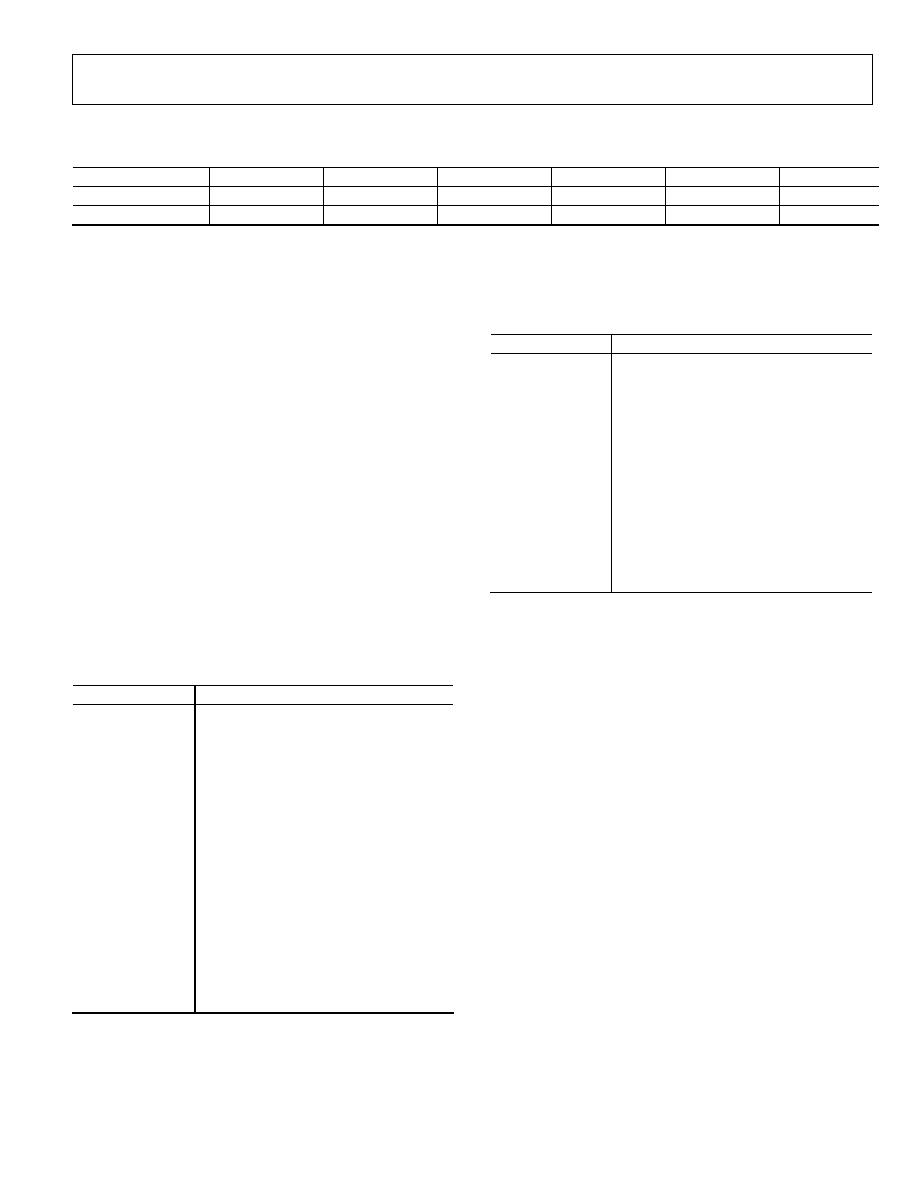
Preliminary Technical Data
ADAU1701
Rev. PrF | Page 31 of 43
MULTIPURPOSE PINS
Table 37. Multipurpose Pin Configuration Registers
Register
Bits[23:20] Bits[19:16] Bits[15:12] Bits[11:8] Bits[7:4]
Bits[3:0]
MP_CFG0
(2080)
MP5[3:0] MP4[3:0] MP3[3:0] MP2[3:0] MP1[3:0] MP0[3:0]
MP_CFG1
(2081)
MP11[3:0]
MP10[3:0]
MP9[3:0] MP8[3:0] MP7[3:0] MP6[3:0]
The ADAU1701 has 12 multipurpose (MP) pins that can be
individually programmed to be used as serial data inputs, serial
data outputs, digital control inputs and outputs to and from the
SigmaDSP core, or as inputs to the four-channel auxiliary ADC.
These pins allow the ADAU1701 to be used with external ADCs
and DACs, take analog or digital inputs to control settings such
as volume control, or output digital signals to drive LED
indicators.
MULTIPURPOSE PIN CONFIGURATION REGISTERS
Each multipurpose pin can be set to its different functions from
these registers (2080-2081). These two three-byte registers are
broken up into twelve 4-bit (nibble) sections that each control a
different MP pin as detailed in Table 37. Table 38 lists the
different functions of each nibble setting within the MP Pin
Configuration Registers. The MSB of each MP pin's 4-bit
configuration inverts the input to or output from the pin. The
MP pins will have an internal pull-up resistor (approximately
10 k) enabled when they are set to digital inputs (either GPIO
input or serial data port input).
Table 38. Multipurpose Pin Configuration Register Bit
Functions
MPx[3:0]
Pin Function
1111
Aux ADC input (see Table 40)
1110 Reserved
1101 Reserved
1100
Serial Data Port ≠ inverted (see Table
44)
1011
Open Collector Output - inverted
1010
GPIO Output ≠ inverted
1001
GPIO Input, no debounce ≠ inverted
1000
GPIO Input, debounced ≠ inverted
0111 N/A
0110 Reserved
0101 Reserved
0100
Serial Data Port (see Table 44)
0011
Open Collector Output
0010
GPIO Output
0001
GPIO Input, no debounce
0000
GPIO Input, debounced
GPIO PIN SETTING REGISTER
This register gives the user access through the control port to
set the GPIO pins. High or low settings can be directly written
to or read from this register after setting bit 7 of the Core
Control Register. This register is updated once every LRCLK
frame (1/fs)
Table 39. GPIO Pin Setting Register (2056)
Register Bits
Function
15:12
Unused
11 MP11
setting
10 MP10
setting
9 MP9
setting
8 MP8
setting
7 MP7
setting
6 MP6
setting
5 MP5
setting
4 MP4
setting
3 MP3
setting
2 MP2
setting
1 MP1
setting
0
MP0 setting
AUXILIARY ADC
The ADAU1701 has a four-channel auxiliary 8-bit ADC that
can be used to connect a potentiometer to control volume, tone,
or other parameter settings in the DSP program. Each of the
four channels is sampled at the audio sampling frequency (f
S
),
which defaults to 48 kHz with a 12.288 MHz crystal connected
to the ADAU1701 oscillator. Full-scale input on this ADC is
3.3V, so the step size is approximately 13mV (3.3V/256 steps).
The input resistance of the ADC is approximate 20 k. Table 40
indicates which four MP pins are mapped to the four channels
of the aux ADC. The aux ADC is enabled for those pins by
writing 1111 to the appropriate pin's portion of the
Multipurpose Pin Configuration Registers.
The auxiliary ADC is turned on by writing a 1 to bit 15 of the
Aux ADC enable register (Table 42).
Noise on the ADC input could cause the digital output to be
constantly changing by a few LSBs. In cases where the aux ADC
is used as a volume control, this would cause small gain
fluctuations. To avoid this, a low-pass filter or hysteresis can be
added to the aux ADC signal path. These functions can be
enabled through the Auxiliary ADC & Power Control Register
(2082), shown in Table 41. The filter is enabled by default when
the aux ADC is enabled. When data is read from the aux ADC
registers, 2 bytes (12 bits of data, plus zero-padded LSBs) are
available because of this filtering.
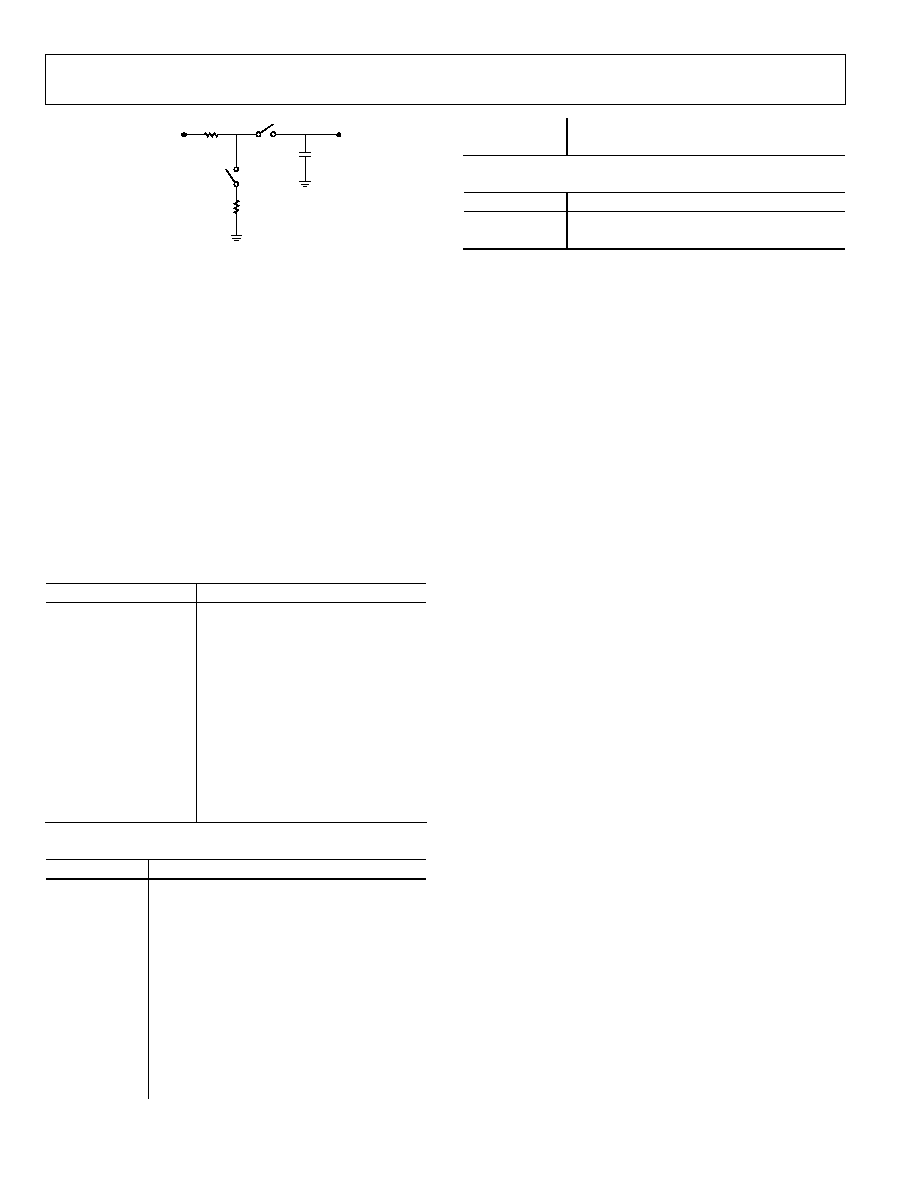
ADAU1701
Preliminary Technical Data
Rev. PrF | Page 32 of 43
Aux ADC
Input Pin
20 k
10 k
S1
S2
1.8 pF
Figure 31. Auxiliary ADC input circuit
Figure 31 shows the input circuit for the auxiliary ADC. Switch
S1 enables the aux ADC, and is set by bit 15 of the Aux ADC
enable register. The sampling switch, S2, operates at the audio
sampling frequency (fs), which is 48 kHz with a 12.288 MHz
crystal connected to the chip's oscillator.
The aux ADC registers can be written to directly after bit 8 in
the DSP core control register has been set. In this mode, the
voltages on the analog inputs are not written into the registers,
but rather the data in the registers is written from the control
port. These registers take a single byte of data when in control
port write mode.
PVDD supplies the 3.3 V power for the aux ADC's analog input.
The digital core of the aux ADC is powered with the 1.8 V
DVDD signal.
Table 40. Multi-Purpose Pin Aux ADC Mapping
Multipurpose Pin
Function
MP0 N/A
MP1 N/A
MP2 ADC1
MP3 ADC2
MP4 N/A
MP5 N/A
MP6 N/A
MP7 N/A
MP8 ADC3
MP9 ADC0
MP10 N/A
MP11 N/A
Table 41. Auxiliary ADC & Power Control Register (2082)
Register Bits
Function
15:10
Reserved, set to 0
9:8
Aux ADC Filtering
00 = 4-bit hysteresis (12 bit level)
01 = 5-bit hysteresis (12 bit level)
01 = Hysteresis bypassed
11 = Low-pass filter bypassed
7
ADC power-down (both ADCs)
6
Voltage reference buffer power-down
5
Voltage reference power-down
4
Reserved, set to 0
3 DAC0
power-down
2 DAC1
power-down
1 DAC2
power-down
0 DAC3
power-down
Table 42. Aux ADC Enable Register (2084)
Register Bits
Function
15
Enable Auxiliary ADC
14:0
Reserved, set to 0
GENERAL PURPOSE INPUT/OUTPUTS
The general purpose input/output (GPIO) pins can be used as
either inputs or outputs. These pins are readable and settable
either through the control interface or directly by the SigmaDSP
core. When set as inputs, they can be used with push-button
switches or rotary encoders to control DSP program settings.
Digital outputs may be used to drive LEDs or external logic to
indicate the status of internal signals and control other devices.
Examples of this use include indicating signal overload, signal
present, and button press confirmation.
When set as outputs, these pins can typically drive 5 mA. This is
enough current to directly drive high-efficiency LEDs, which
typically need 2-4 mA. Standard LEDs require about 20 mA and
can be driven from a GPIO output with an external transistor or
buffer. When the GPIO pins are set as open-collector outputs,
they should be pulled up to a maximum voltage of 3.3 V (the
voltage on IOVDD).
SERIAL DATA INPUT/OUTPUT PORTS
The ADAU1701's flexible serial data input and output ports can
be set to accept or transmit data in 2-channel formats or in an
8-channel TDM stream. Data is processed in twos complement,
MSB-first format. The left channel data field always precedes
the right channel data field in the 2-channel streams. In the
TDM modes, slots 0 to 3 fall in the first half of the audio frame,
and slots 4 to 7 are in the second half of the frame. TDM mode
allows fewer multipurpose pins to be used, freeing more pins
for other functions. The serial modes are set in the serial output
and serial input control registers.
The serial data clocks need to be synchronous with the
ADAU1701's master clock input.
The input control register allows control of clock polarity and
data input modes. The valid data formats are I
2
S , left-justified,
right-justified (24-, 20-, 18-, or 16-bit), and 8-channel TDM. In
all modes except for the right-justified modes, the serial port
will accept an arbitrary number of bits up to a limit of 24. Extra
bits will not cause an error, but they will be truncated internally.
Proper operation of the right-justified modes requires that there
be exactly 64 BCLKs per audio frame. The TDM data is input
on SDATA_IN0. The LRCLK in TDM mode can be input to the
ADAU1701 either as a 50/50 duty cycle clock or as a bit-wide
pulse.
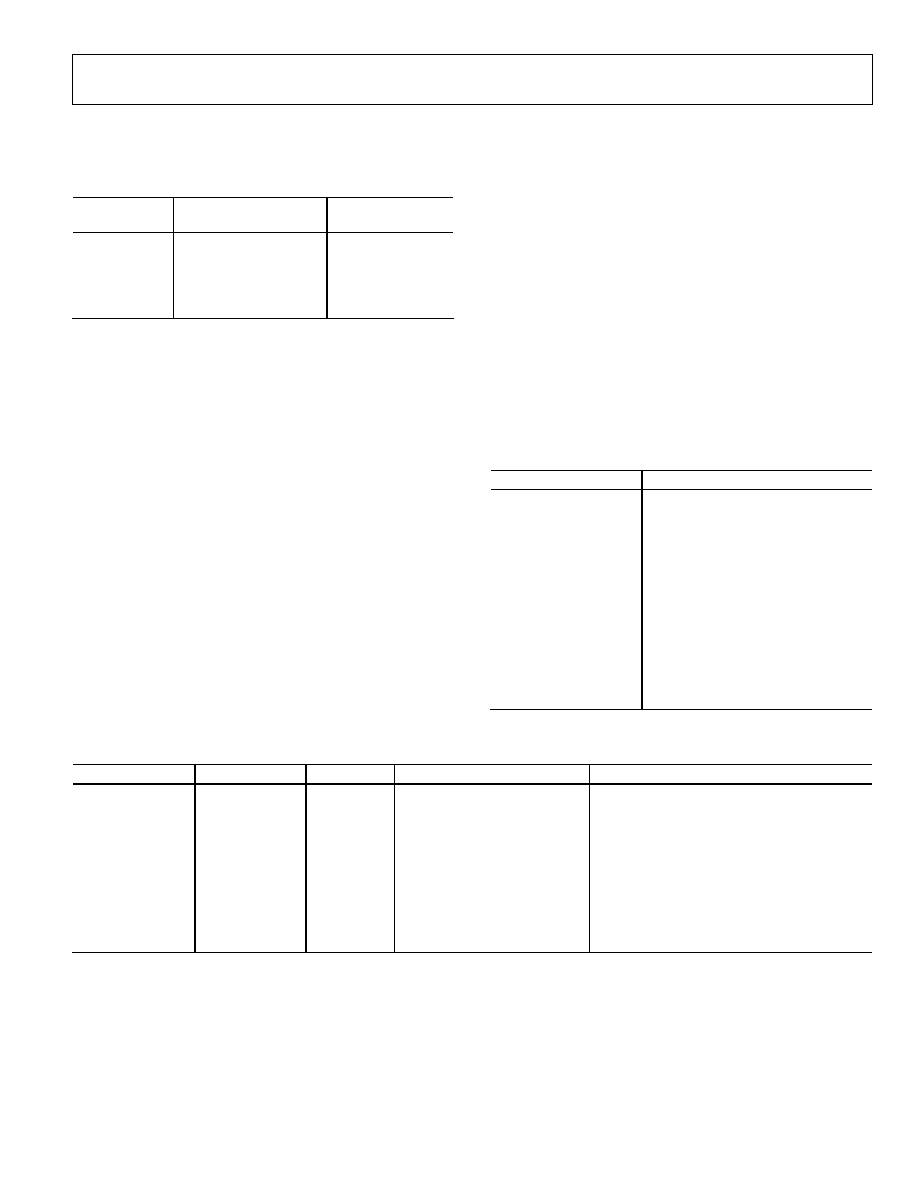
Preliminary Technical Data
ADAU1701
Rev. PrF | Page 33 of 43
In TDM mode, the ADAU1701 can be a master for 48 kHz and
96 kHz data, but not for 192 kHz data. Table 43 displays the
modes in which the serial output port will function.
Table 43. Serial Output Port Master/Slave Mode Capabilities
f
S
2-Channel Modes
(I
2
S, LJ, RJ)
8-Channel
TDM
48 kHz
Master and slave
Master and
slave
96 kHz
Master and slave
Master and
slave
192 kHz
Master and slave
Slave only
The output control registers give the user control of clock
polarities, clock frequencies, clock types, and data format. In all
modes except for the right-justified modes (MSB delayed by 8,
12, or 16), the serial port accepts an arbitrary number of bits up
to a limit of 24. Extra bits will not cause an error, but will be
truncated internally. Proper operation of the right-justified
modes requires the LSB to align with the edge of the LRCLK.
The default settings of all serial port control registers
correspond to 2-channel I
2
S mode. All register settings apply to
both master and slave modes unless otherwise noted.
The functions of the individual multi-purpose pins in serial
data port mode are shown in Table 44. Pins MP0-5 support
digital data input to the ADAU1701 and pins MP6-11 handle
digital data output from the DSP. The configuration of the serial
data input port is set in the Serial Input Control Register (Table
47) and the output port is controlled with the Serial Output
Control Register (Table 46). The input port clocks function only
as slaves and the output port clocks can be set to be either
master or slave. The INPUT_LRCLK and INPUT_BCLK pins
(MP4 & MP5) are used to clock the SDATA_INx signals (MP0-
3) and the OUTPUT_LRCLK and OUTPUT BCLK (MP10 &
MP11) are used to clock the SDATA_OUTx signals (MP6-9).
If an external ADC will be connected as a slave to the
ADAU1701, both the input and output port clocks will need to
be used. The output LRCLK and BCLK (MP10 & MP11) will
need to be set into master mode and connected externally to the
input LRCLK and BCLK pins (MP4 & MP5) and the external
ADC's clock input pins. The data will be output from the
external ADC into the SigmaDSP on one of the four SDATA_IN
pins (MP0-3).
Connections to an external DAC are handled exclusively with
the output port pins. The output LRCLK and BCLK can be set
to be either master or slave, and the SDATA_OUT pins are used
to output data from the SigmaDSP to the external DAC.
Table 45 shows the proper configurations for standard audio
data formats.
Table 44. Multi-Purpose Pin Serial Data Port Functions
Multipurpose Pin
Function
MP0 SDATA_IN0/TDM_IN
MP1 SDATA_IN1
MP2 SDATA_IN2
MP3 SDATA_IN3
MP4
INPUT_LRCLK (slave only)
MP5
INPUT_BCLK (slave only)
MP6 SDATA_OUT0/TDM_OUT
MP7 SDATA_OUT1
MP8 SDATA_OUT2
MP9 SDATA_OUT3
MP10
OUTPUT_LRCLK (master or slave)
MP11
OUTPUT_BCLK (master or slave)
Table 45. Data Format Configurations
Format
LRCLK Polarity
LRCLK Type
BCLK Polarity
MSB Position
I
2
S (Figure 32)
Frame begins on
falling edge
Clock
Data changes on falling edge
Delayed from LRCLK edge by one BCLK
Left-Justified
(Figure 33)
Frame begins on
rising edge
Clock
Data changes on falling edge
Aligned with LRCLK edge
Right-Justified
(Figure 34)
Frame begins on
rising edge
Clock
Data changes on falling edge
Delayed from LRCLK edge by 8, 12, or 16 BCLKs
TDM with Clock
(Figure 35)
Frame begins on
falling edge
Clock
Data changes on falling edge
Delayed from start of word clock by one BCLK
TDM with Pulse
(Figure 36)
Frame begins on
rising edge
Pulse
Data changes on falling edge
Delayed from start of word clock by one BCLK

ADAU1701
Preliminary Technical Data
Rev. PrF | Page 34 of 43
Table 46. Serial Output Control Register (2078)
Register Bits
Function
15:14 Unused
13
OUTPUT_LRCLK Polarity
0 = Frame Begins on Falling Edge
1 = Frame Begins on Rising Edge
12
OUTPUT_BCLK Polarity
0 = Data Changes on Falling Edge
1 = Data Changes on Rising Edge
11
Master/Slave
0 = Slave
1 = Master
10:9
OUTPUT_BCLK Frequency (Master Mode only)
00 = core_clock/16
01 = core_clock/8
10 = core_clock/4
11 = core_clock/2
8:7
OUTPUT_LRCLK (Master Mode only)
00 = core_clock/1024
01 = core_clock/512
10 = core_clock/256
6
Frame Sync Type
0 = LRCLK
1 = Pulse
5
Serial Output/TDM Mode Control
0 = 8 Serial Data Outputs
1 = Enable TDM on SDATA_OUTx
4:2
MSB Position
000 = Delay by 1
001 = Delay by 0
010 = Delay by 8
011 = Delay by 12
100 = Delay by 16
101 Reserved
111 Reserved
1:0
Output Word Length
00 = 24 Bits
01 = 20 Bits
10 = 16 Bits
11 = Reserved
SERIAL OUTPUT CONTROL REGISTERS
OUTPUT_LRCLK Polarity (Bit 13)
When set to 0, the left channel data is clocked when
OUTPUT_LRCLK is low, and the right channel data clocked
when OUTPUT_LRCLK is high. When set to 1, the right
channel data is clocked when OUTPUT_LRCLK is low, and the
left channel data clocked when OUTPUT_LRCLK is high.
OUTPUT_BCLK Polarity (Bit 12)
This bit controls on which edge of the bit clock the output data
is clocked. Data changes on the falling edge of OUTPUT_BCLK
when this bit is set to 0, and on the rising edge when this bit is
set at 1.
Master/Slave (Bit 11)
This bit sets whether the output port is a clock master or slave.
The default setting is slave; on power-up, Pins OUTPUT_BCLK
and OUTPUT_LRCLK are set as inputs until this bit is set to 1,
at which time they become clock outputs.
OUTPUT_BCLK Frequency (Bits 10:9)
When the output port is being used as a clock master, these bits
set the frequency of the output bit clock, which is divided down
from the internal 49.152 MHz core clock.
OUTPUT_LRCLK Frequency (Bits 8:7)
When the output port is used as a clock master, these bits set
the frequency of the output word clock on the
OUTPUT_LRCLK pins, which is divided down from the
internal 49.152 MHz
core clock.
Frame Sync Type (Bit 6)
This bit sets the type of signal on the OUTPUT_LRCLK pins.
When set to 0, the signal is a word clock with a 50% duty cycle;
when set to 1, the signal is a pulse with a duration of one bit
clock at the beginning of the data frame.
Serial Output/TDM Mode Control (Bit 5)
Setting this bit to 1 changes the output port from multiple serial
outputs to a single TDM output stream on the appropriate
SDATA_OUTx pin. This bit must be set in both serial output
control registers to enable 16-channel TDM on SDATA_OUT0.
MSB Position (Bits 4:2)
These three bits set the position of the MSB of data with respect
to the LRCLK edge. The data output of the ADAU1701 is always
MSB first.
Output Word Length (Bits 1:0)
These bits set the word length of the output data-word. All bits
following the LSB are set to 0.
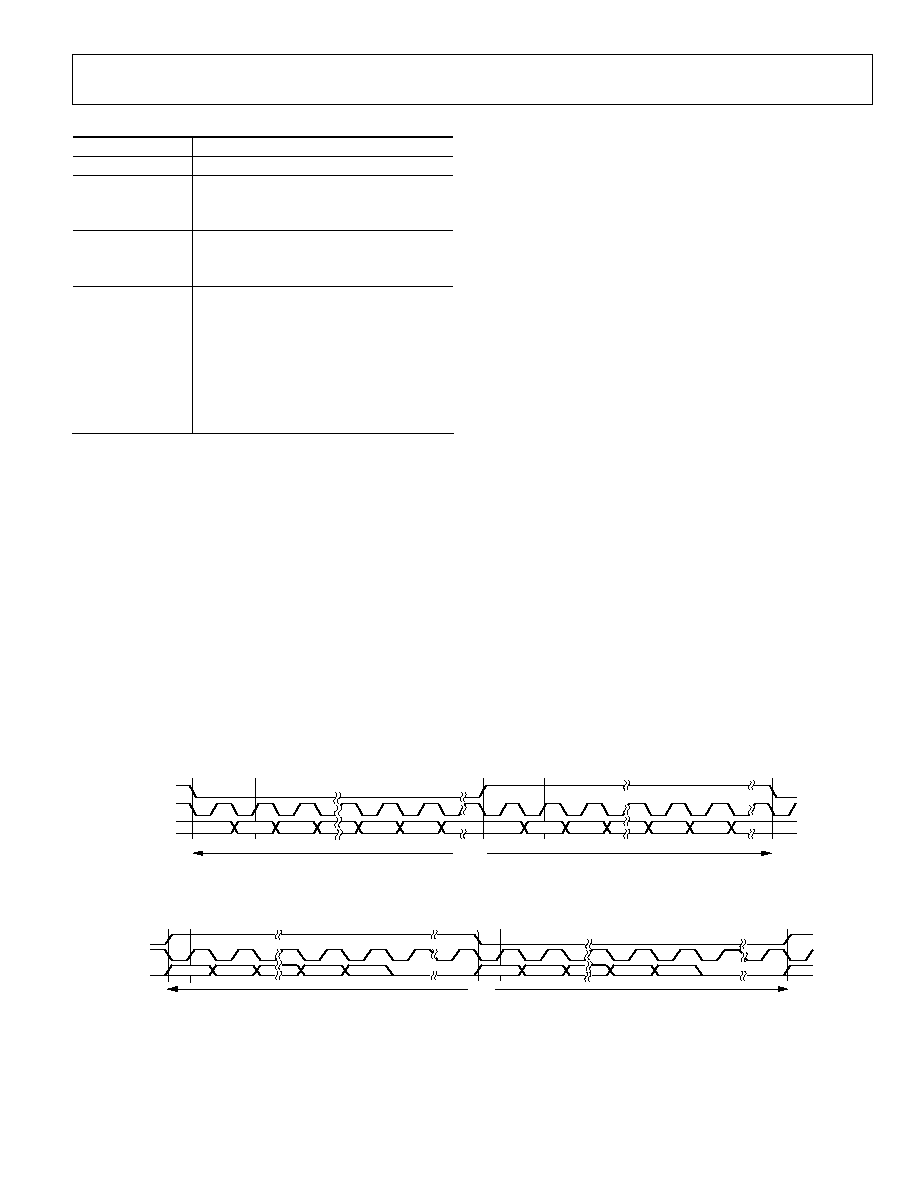
Preliminary Technical Data
ADAU1701
Rev. PrF | Page 35 of 43
Table 47. Serial Input Control Register (2079)
Register Bits
Function
7:5 Unused
4
INPUT_LRCLK polarity
0 = Frame begins on falling edge
1 = Frame begins on rising edge
3
INPUT_BCLK polarity
0 = Data changes on falling edge
1 = Data changes on rising edge
2:0
Serial Input Mode
000 = I
2
S
001 = Left-justified
010 = TDM
011 = Right-justified, 24-bit
100 = Right-justified, 20-bit
101 = Right-justified, 18-bit
110 = Right-justified, 16-bit
SERIAL INPUT CONTROL REGISTER
INPUT_LRCLK Polarity (Bit 4)
When set to 0, the left channel data on the SDATA_INx pins is
clocked when INPUT_LRCLK is low; and the right input data
clocked when INPUT_LRCLK is high. When set to 1, this is
reversed. In TDM mode, when this bit is set to 0, data is clocked
in starting with the next appropriate BCLK edge (set in Bit 3 of
this register) following a falling edge on the INPUT_LRCLK
pin. When set to 1 and running in TDM mode, the input data is
valid on the BCLK edge following a rising edge on the word
clock (INPUT_LRCLK). INPUT_LRCLK can also operate with
a pulse input, rather than a clock. In this case, the first edge of
the pulse is used by the ADAU1701 to start the data frame.
When this polarity bit is set to 0, a low pulse should be used,
and a high pulse should be used when the bit it set to 1.
INPUT_BCLK Polarity (Bit 3)
This bit controls on which edge of the bit clock the input data
changes, and on which edge it is clocked. Data changes on the
falling edge of INPUT_BCLK when this bit is set to 0, and on
the rising edge when this bit is set at 1.
Serial Input Mode (Bits 2:0)
These two bits control the data format that the input port
expects to receive. Bits 3 and 4 of this control register will
override the settings in Bits 2:0, so all four bits must be changed
together for proper operation in some modes. The clock
diagrams for these modes are shown in Figure 32, Figure 33,
and Figure 34. Note that for left-justified and right-justified
modes the LRCLK polarity is high, then low, which is opposite
from the default setting of Bit 4.
When these bits are set to accept a TDM input, the ADAU1701's
data starts after the edge defined by Bit 4. The ADAU1701's
TDM data stream should be input on pin SDATA_IN0. Figure
35 shows a TDM stream with a high-to-low triggered LRCLK
and data changing on the falling edge of the BCLK. The
ADAU1701 expects the MSB of each data slot delayed by one
BCLK from the beginning of the slot, just like in the stereo I
2
S
format. In TDM mode, Channels 0 to 3 will be in the first half
of the frame, and Channels 4 to 7 will be in the second half.
Figure 36 shows an example of a TDM stream running with a
pulse word clock, which would be used to interface to ADI
codecs in their auxiliary mode. To work in this mode on either
the input or output serial ports, the ADAU1701 should be set to
frame beginning on the rising edge of LRCLK, data changing on
the falling edge of BCLK, and MSB position delayed from the
start of the word clock by one BCLK.
LRCLK
BCLK
SDATA
MSB
LEFT CHANNEL
LSB
MSB
RIGHT CHANNEL
LSB
1 /F
S
04607-0-023
Figure 32. I
2
S Mode--16 to 24 Bits per Channel
LRCLK
BCLK
SDATA
LEFT CHANNEL
MSB
LSB
MSB
RIGHT CHANNEL
LSB
1 /F
S
04607-0-024
Figure 33. Left-Justified Mode--16 to 24 Bits per Channel
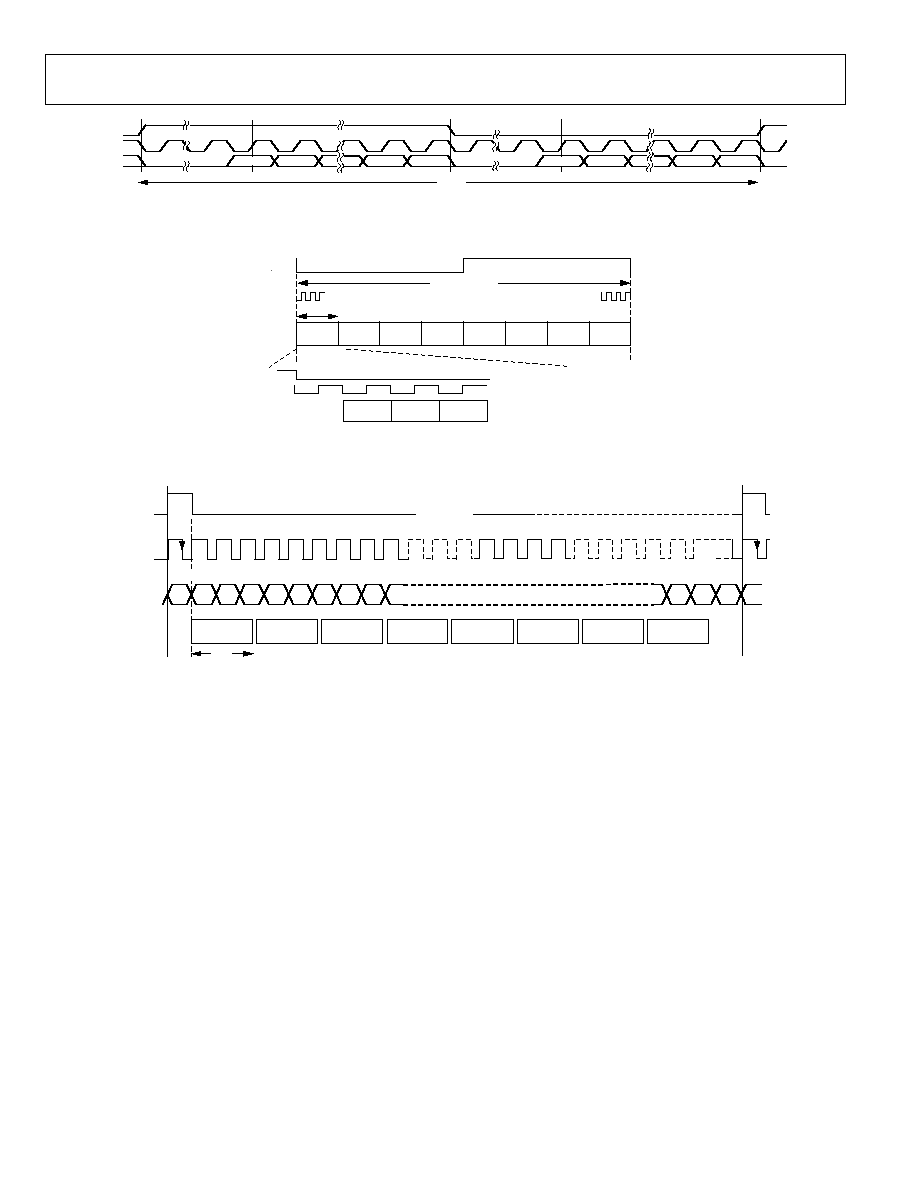
ADAU1701
Preliminary Technical Data
Rev. PrF | Page 36 of 43
LRCLK
BCLK
SDATA
LEFT CHANNEL
MSB
LSB
MSB
RIGHT CHANNEL
LSB
1 /F
S
04607-0-025
Figure 34. Right-Justified Mode--16 to 24 Bits per Channel
LRCLK
BCLK
DATA
SLOT 1
SLOT 2
SLOT 5
SLOT 6
32 BCLKs
MSB
MSB≠1
MSB≠2
256 BCLKs
SLOT 3
SLOT 4
SLOT 7
SLOT 8
LRCLK
BCLK
DATA
04607-0-012
Figure 35. TDM Mode
LRCLK
SLOT 0
SLOT 1
SLOT 2
SLOT 3
SLOT 4
SLOT 5
SLOT 6
SLOT 7
CH
0
BCLK
SDATA
MSB TDM
8TH
CH
32
BCLKs
MSB TDM
04607-0-022
Figure 36. TDM Mode with Pulse Word Clock

Preliminary Technical Data
ADAU1701
Rev. PrF | Page 37 of 43
LAYOUT RECOMMENDATIONS
PARTS PLACEMENT
The ADC input voltage-to-current resistors and the ADC
current set resistor should be placed as close to the input pins
(2, 3 & 4) as possible.
All 100 nF bypass capacitors, which are recommended for every
analog, digital, and PLL power/ground pair, should be placed as
close to the ADAU1701 as possible. Both the 3.3 V and 1.8 V
signals on the board should also each be bypassed with a single
bulk capacitor (10-47 F).
All traces in the crystal oscillator circuit (Figure 16) should be
kept as short as possible to minimize stray capacitance. There
should not be any long board traces connected to any of these
components, as this may affect crystal start-up and operation.
GROUNDING
A single ground plane should be used in the application layout.
Components in an analog signal path should still be placed
away from digital signals.
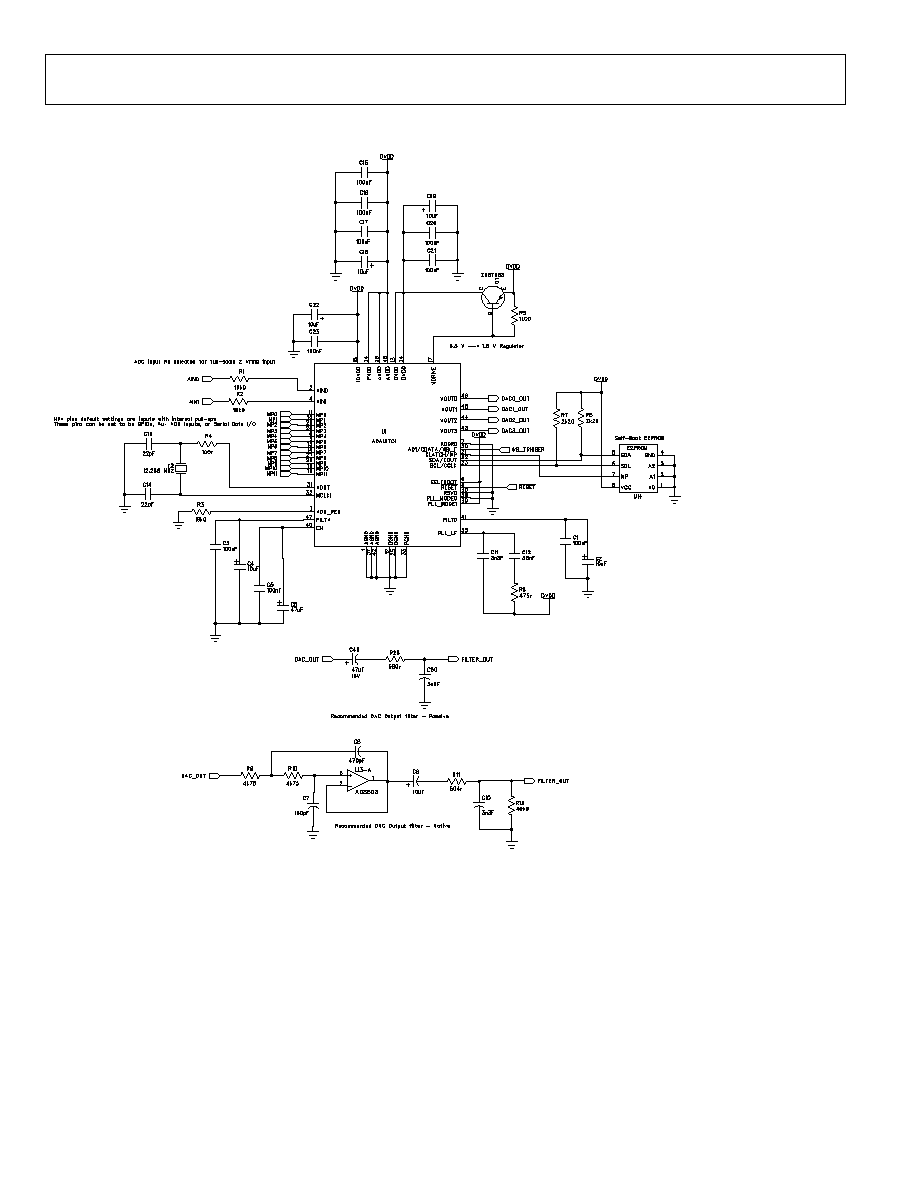
ADAU1701
Preliminary Technical Data
Rev. PrF | Page 38 of 43
TYPICAL APPLICATION SCHEMATIC ≠ SELF BOOT MODE

Preliminary Technical Data
ADAU1701
Rev. PrF | Page 39 of 43
TYPICAL APPLICATION SCHEMATIC ≠ I
2
C CONTROL
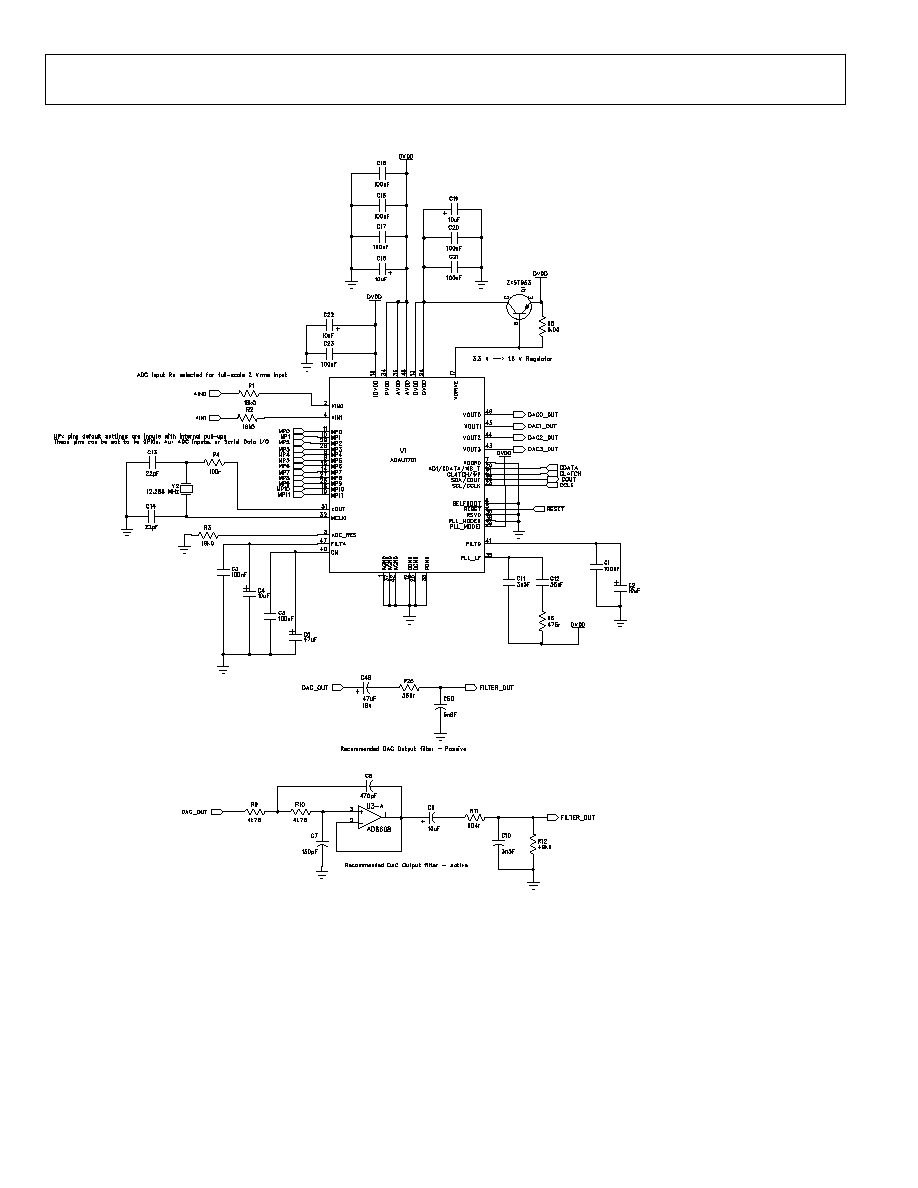
ADAU1701
Preliminary Technical Data
Rev. PrF | Page 40 of 43
TYPICAL APPLICATION SCHEMATIC ≠ SPI CONTROL
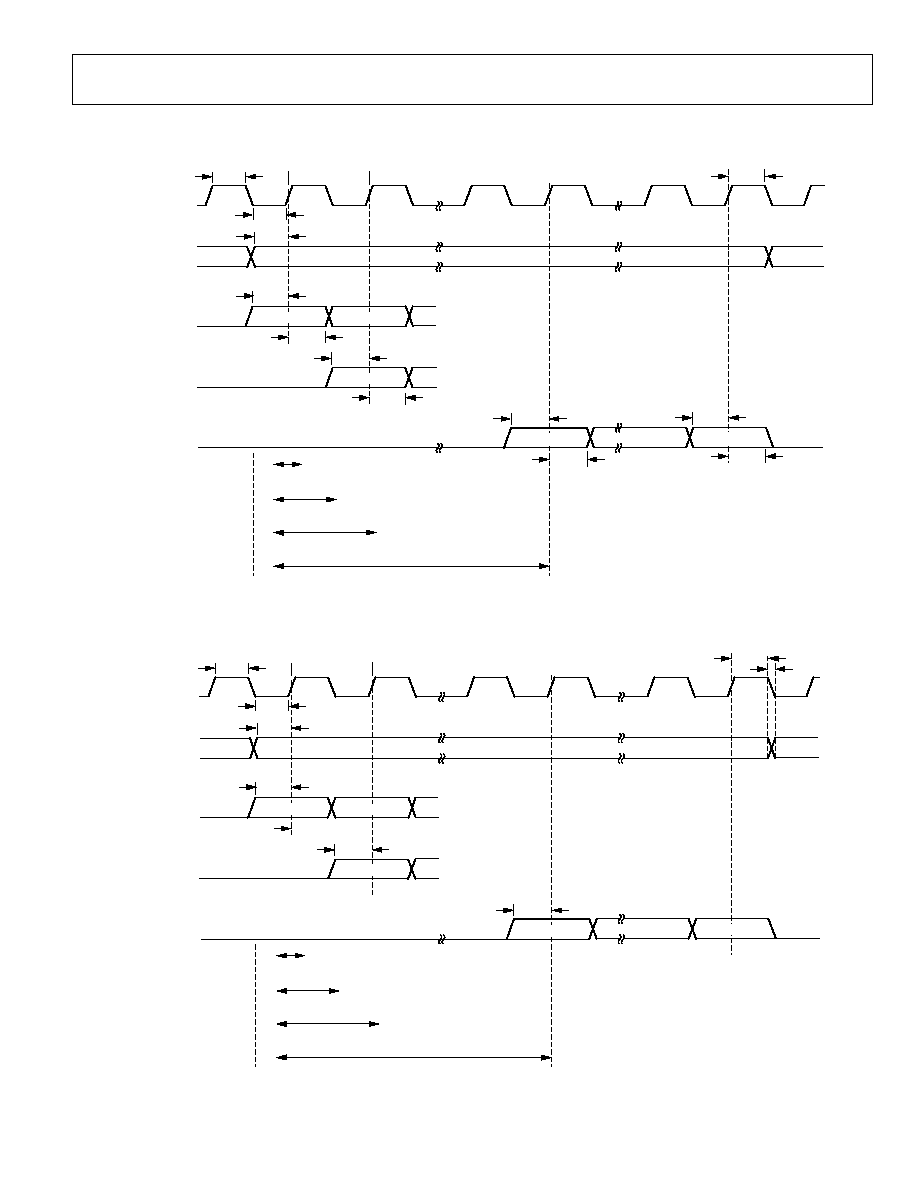
Preliminary Technical Data
ADAU1701
Rev. PrF | Page 41 of 43
DIGITAL TIMING DIAGRAMS
BCLK_IN
LRCLK_IN
SDATA_INX
LEFT-JUSTIFIED
MODE
LSB
SDATA_INX
I
2
S-JUSTIFIED
MODE
SDATA_INX
RIGHT-JUSTIFIED
MODE
t
BIH
MSB
MSB-1
MSB
MSB
8-BIT CLOCKS
(24-BIT DATA)
12-BIT CLOCKS
(20-BIT DATA)
14-BIT CLOCKS
(18-BIT DATA)
16-BIT CLOCKS
(16-BIT DATA)
t
LIS
t
SIS
t
SIH
t
SIH
t
SIS
t
SIS
t
SIH
t
SIS
t
SIH
t
LIH
t
BIL
04607-0-013
Figure 37. Serial Input Port Timing
BCLK_OUTX
LRCLK_OUTX
SDATA_OUTX
LEFT-JUSTIFIED
MODE
LSB
SDATA_OUTX
I
2
S-JUSTIFIED
MODE
SDATA_OUTX
RIGHT-JUSTIFIED
MODE
t
BIH
MSB
MSB-1
MSB
MSB
8-BIT CLOCKS
(24-BIT DATA)
12-BIT CLOCKS
(20-BIT DATA)
14-BIT CLOCKS
(18-BIT DATA)
16-BIT CLOCKS
(16-BIT DATA)
t
LOS
t
SDDS
t
SDDM
t
SDDS
t
SDDM
t
SDDS
t
SDDM
t
LCH
t
TS
t
BIL
04607-0-014
Figure 38. Serial Output Port Timing
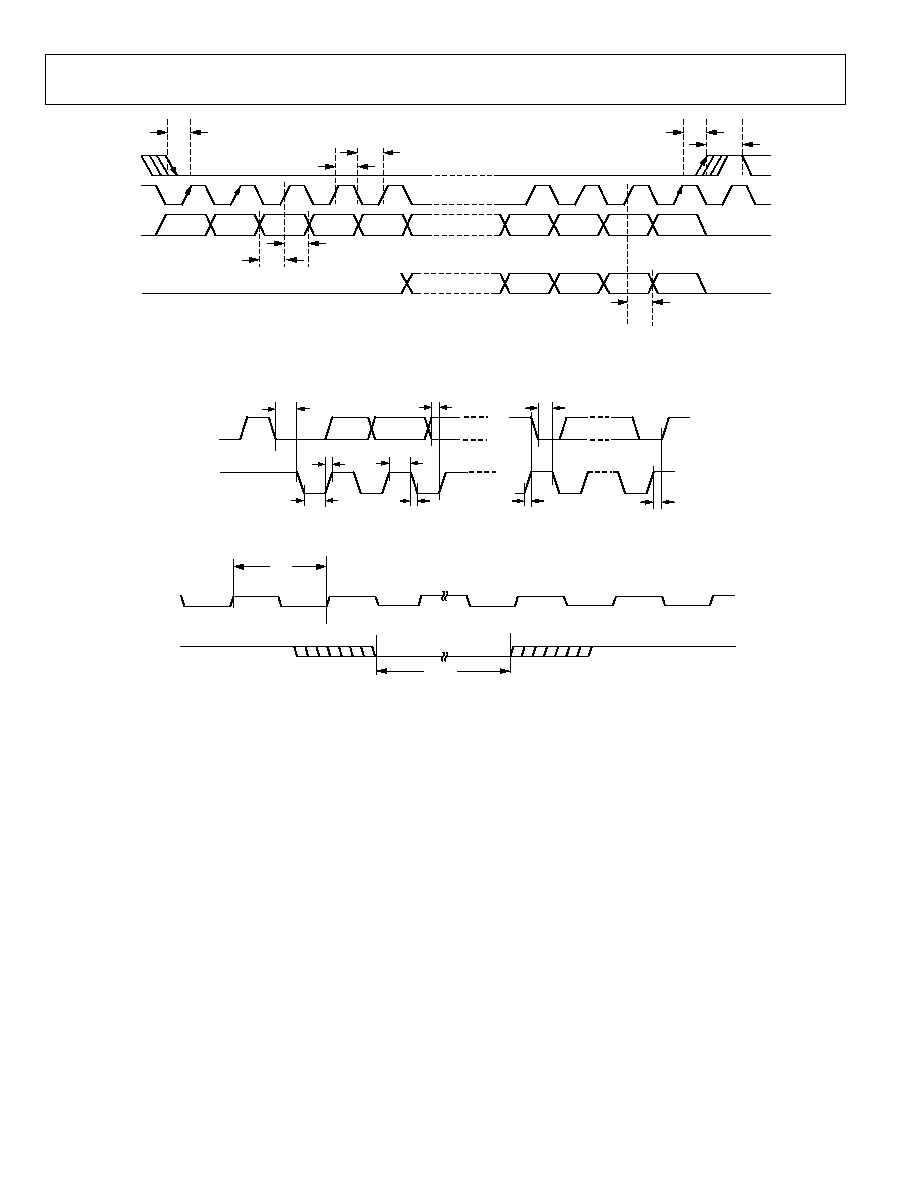
ADAU1701
Preliminary Technical Data
Rev. PrF | Page 42 of 43
CLATCH
CCLK
CDATA
COUT
t
CLS
t
CDS
t
CDH
t
COD
t
CCPH
t
CCPL
t
CLH
t
CLPH
04607-0-015
Figure 39. SPI Port Timing
t
TSCH
t
SCLH
t
SR
t
SCLL
t
ST
t
DS
SDA
SCLK
t
TSCH
t
SSH
04607-026
t
SCS
Figure 40. I
2
C Port Timing
MCLK
RESETB
t
MP
t
RLPW
04607-0-016
Figure 41. Master Clock and Reset Timing
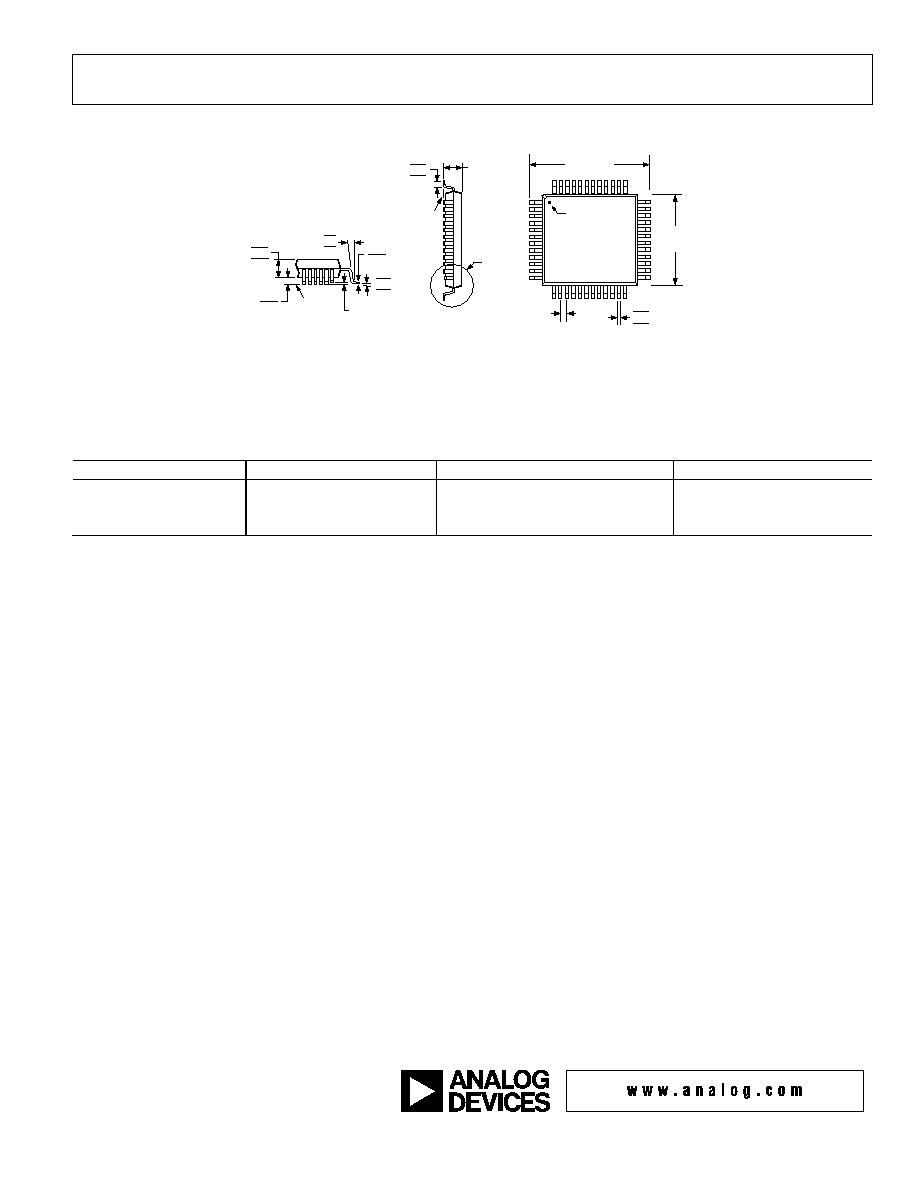
Preliminary Technical Data
ADAU1701
Rev. PrF | Page 43 of 43
OUTLINE DIMENSIONS
TOP VIEW
(PINS DOWN)
1
12
13
25
24
36
37
48
0.27
0.22
0.17
0.50
BSC
7.00
BSC SQ
SEATING
PLANE
1.60
MAX
0.75
0.60
0.45
VIEW A
9.00 BSC
SQ
PIN 1
0.20
0.09
1.45
1.40
1.35
0.08 MAX
COPLANARITY
VIEW A
ROTATED 90
∞
CCW
SEATING
PLANE
10∞
6∞
2∞
7∞
3.5∞
0∞
0.15
0.05
COMPLIANT TO JEDEC STANDARDS MS-026BBC
Figure 42. 48-Lead Low-Profile Quad Flat Package [LQFP]
Dimensions Shown in Millimeters
ORDERING GUIDE
Model
Temperature Range
Package Description
Package Option
ADAU1701JSTZ
1
0∞C to 70∞C
48-Lead LQFP
ST-48
ADAU1701JSTZ-RL
0∞C to 70∞C
48-Lead LQFP
ST-48 in 13" Reel
EVAL-ADAU1701EB
Evaluation
Board
1
Z = Pb-free
©2006 Analog Devices, Inc. All rights reserved. Trademarks and
registered trademarks are the property of their respective owners.
PR05797-0-5/06(PrF)










































